CRITTERS
AT BBSP AND ELSEWHERE page 6 Insects: non-toxic
This
page was born 10/31/2005. Rickubis designed it.
(such as it
is.) Last update: 06/30/2023
Images
and contents on this page copyright © 2002-2023 Richard M. Dashnau
Go back to my
home page, Welcome
to rickubis.com
Go
back to the RICKUBISCAM
page.
----------------------------------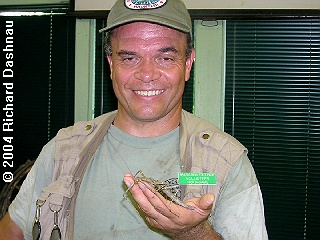
Welcome
to the Visitor's Center at Brazos Bend State Park. That's me
with the
giant
walking stick (06/20/2004). As I get more material in my domain,
I'm
able
to give a separate
page to various animals. This page features non-toxic
insects. I feel that toxic insects each should have their own
page for
easier reference.
05/28/2023 Brazos Bend
State
Park A week ago 5/18, I had noticed that the den I call the "40
Acre
West Den" by the Buttonbush (Cephalantus
occidentalis)
showed
new signs of use (grass flattened, slide mark in mud). Since
then, I've been stopping by to see if I could find an
alligator
in or near it. There appears
to be a grassy hump
in front of the den, but I don't think it's a nest. After
comparing
with older images, I can see that the hump has always been there.
Grass
grew on it, and
now that it's flattened it gives the illusion of a
pile of grass stalks. I believe that it's just a layer of crushed
grass
on top of the mud hump and not a pile of old grass. The 4
images below show the den earlier this year.
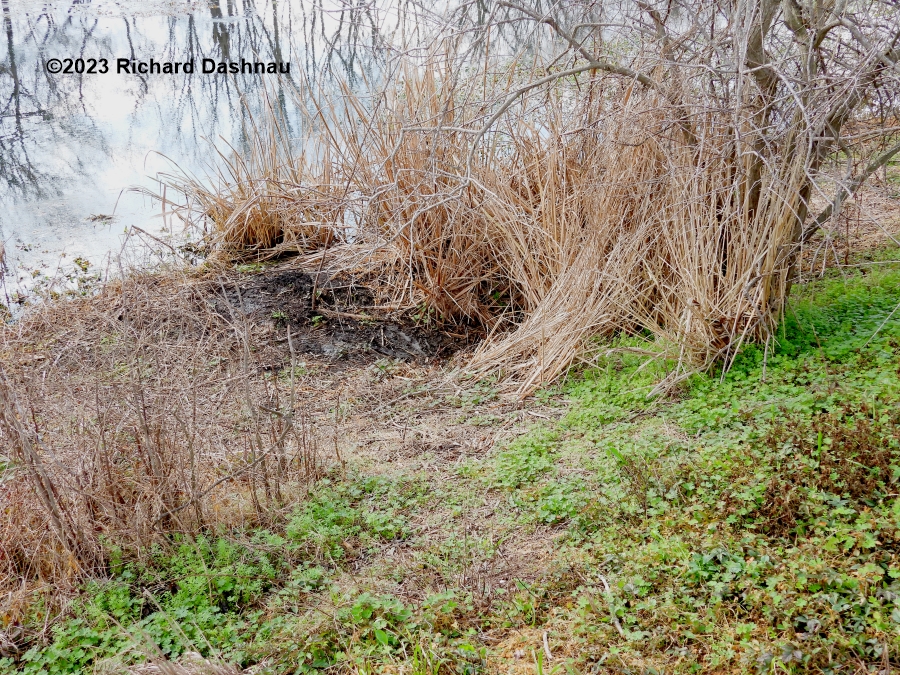
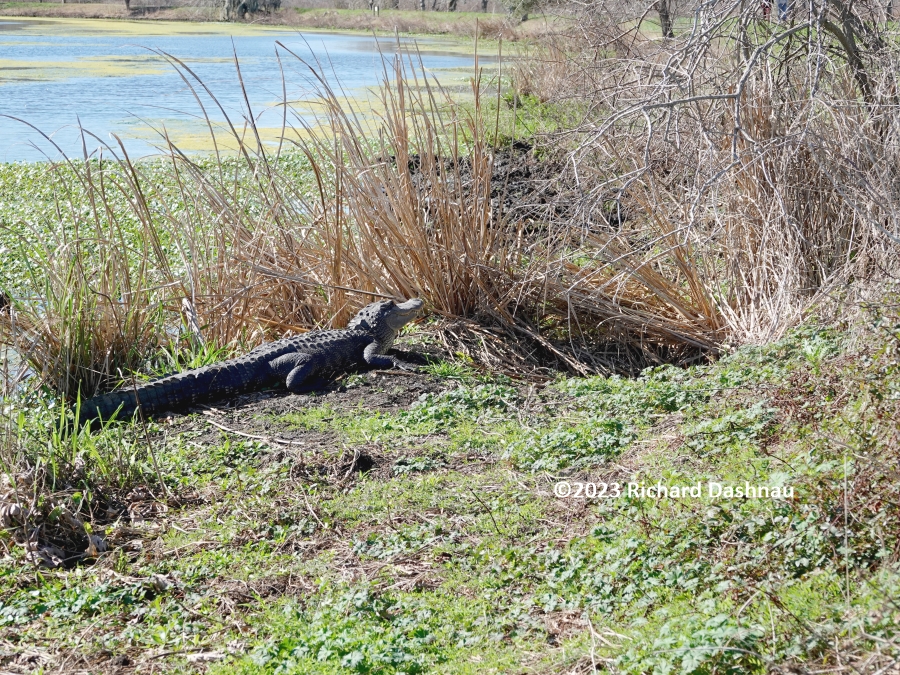
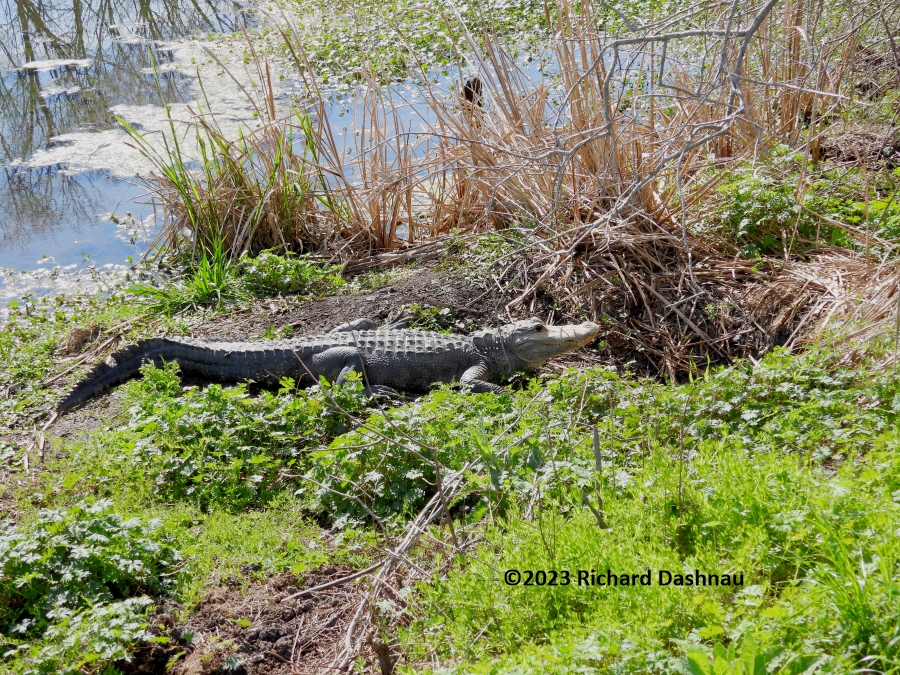
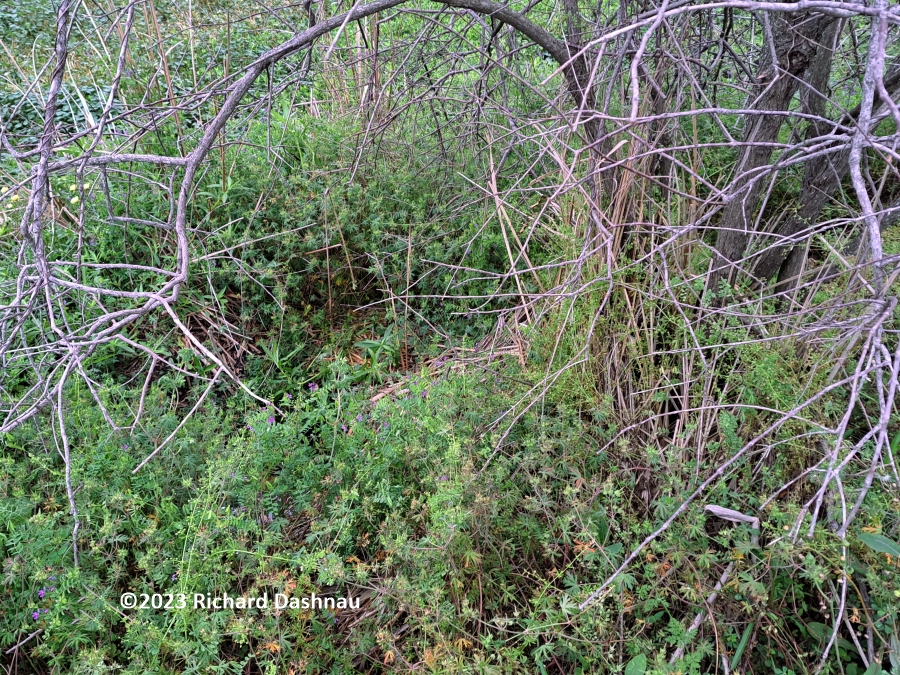
01/01/2023
01/22/2023
02/12/2023
03/19/2023
While looking at the bush today, I
noticed the amazing flowers on the Buttonbush (Cephalantus
occidentalis), and decided to take a few pictures of those.
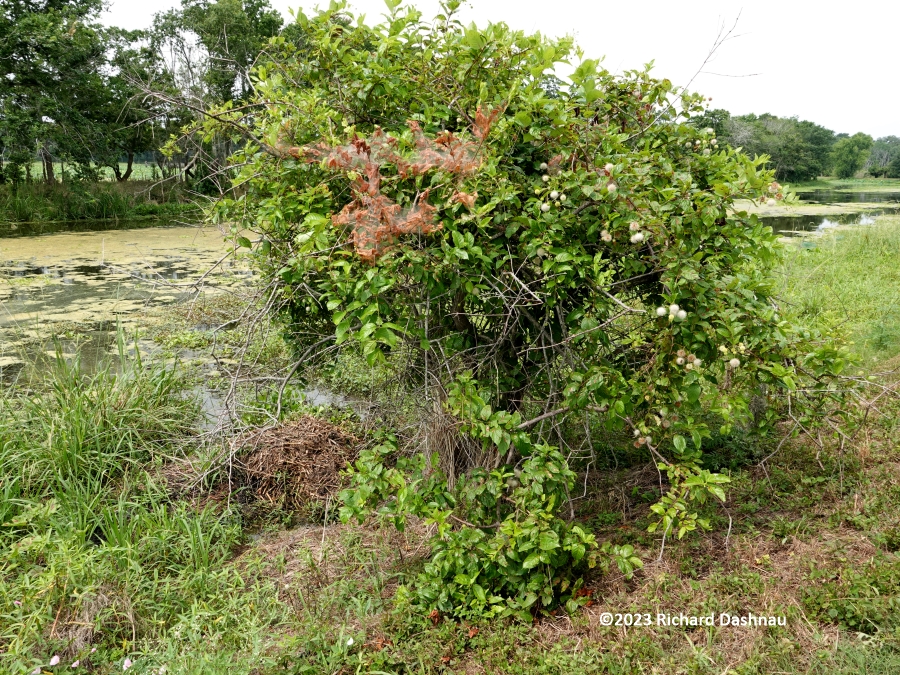
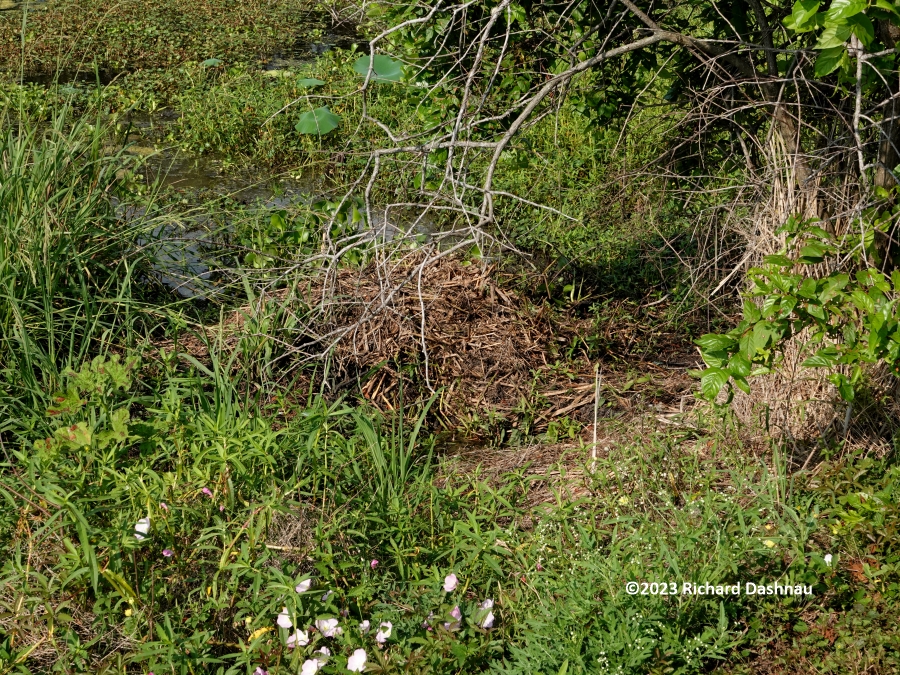
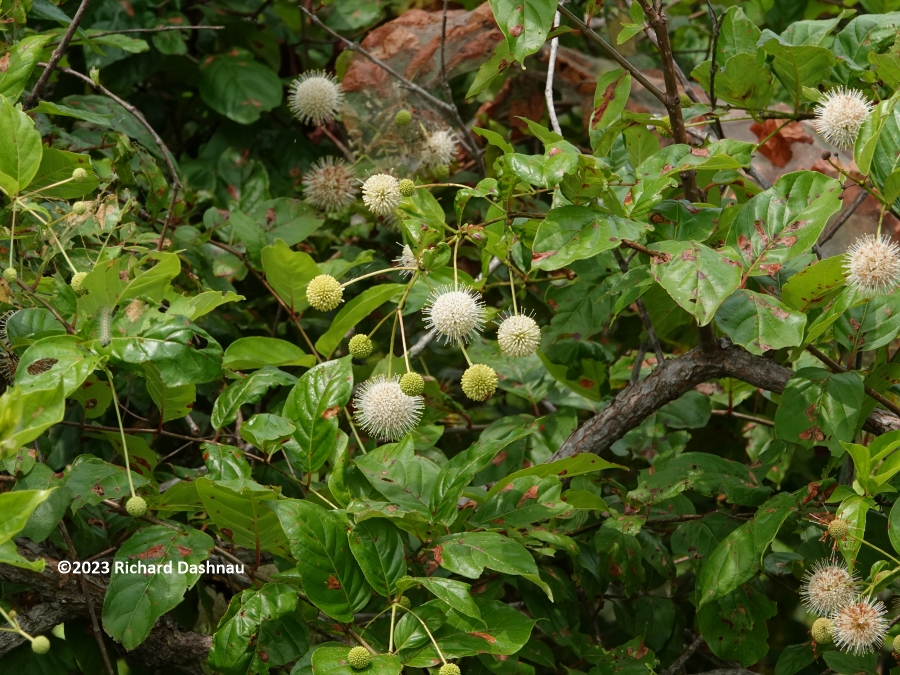
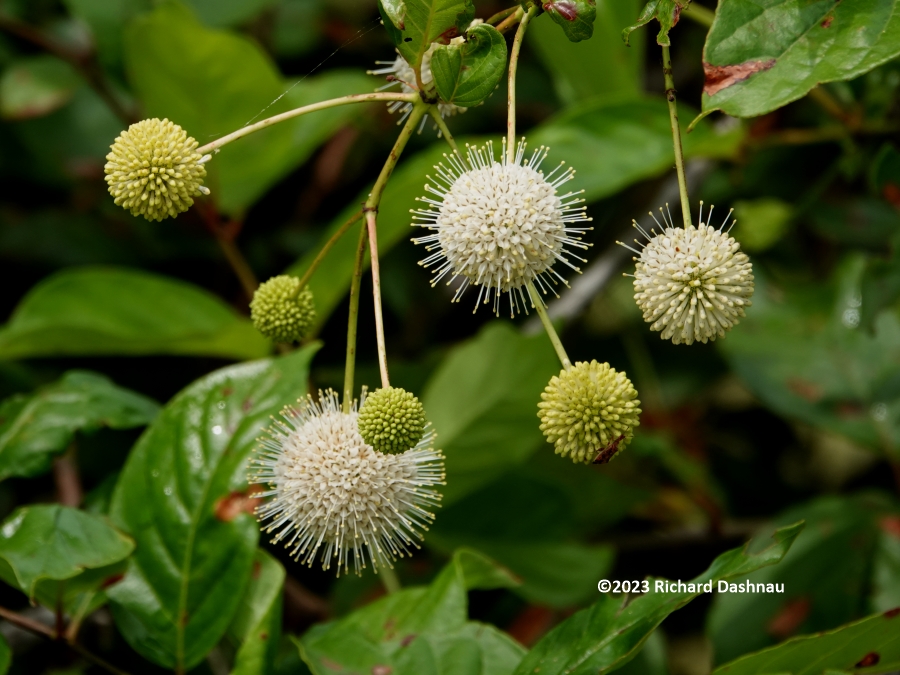
While
I was shooting photos, some butterflies and a few wasps came by. I
think that this was a Black Swallowtail (Papilio polyxenes), and
it's a
male--at least judging
from the colors when I compared with images online. I
thought
my photos were nice, so here they are.
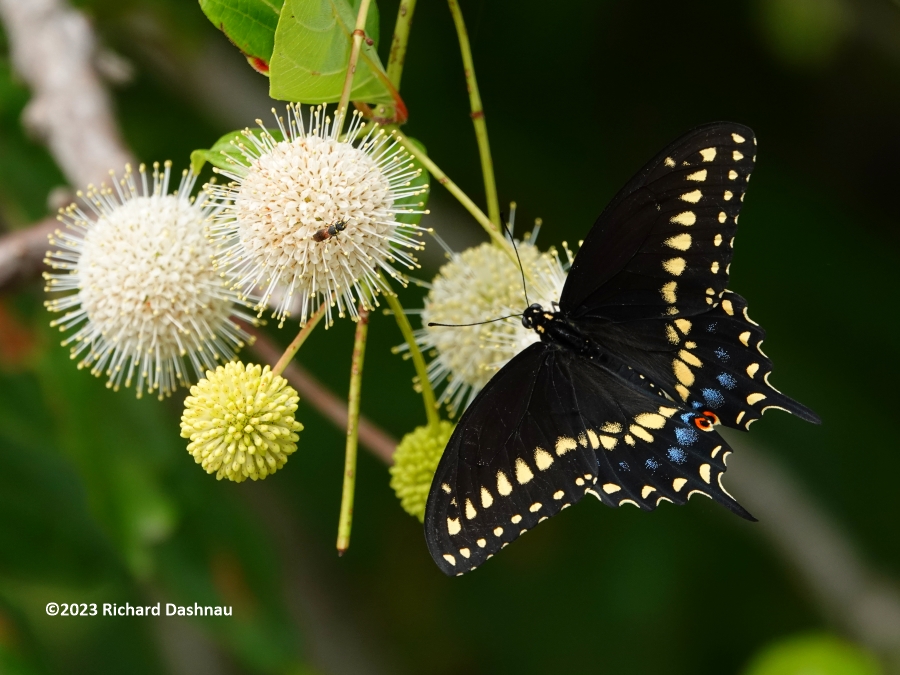
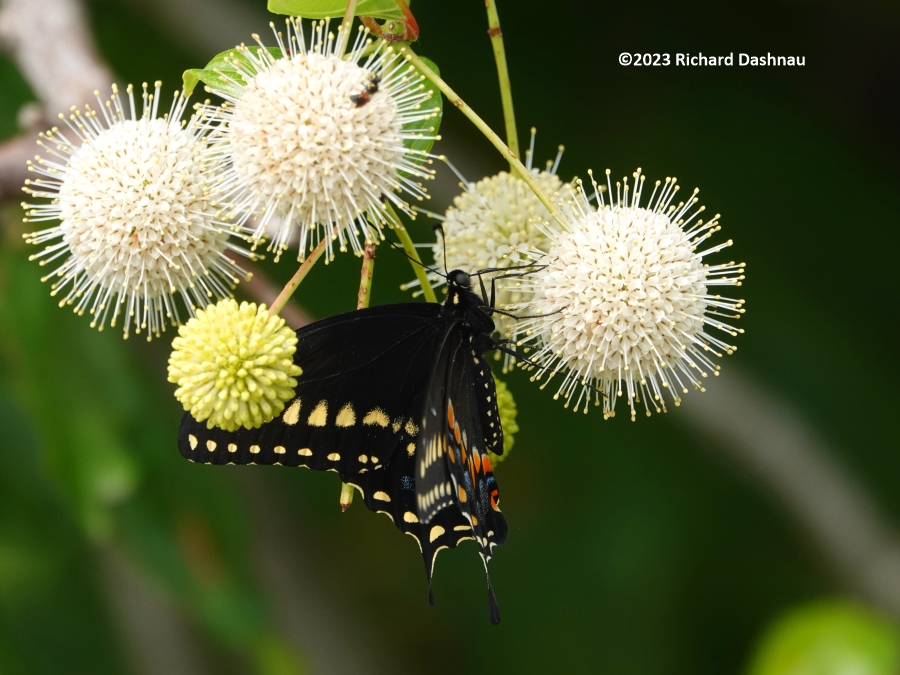
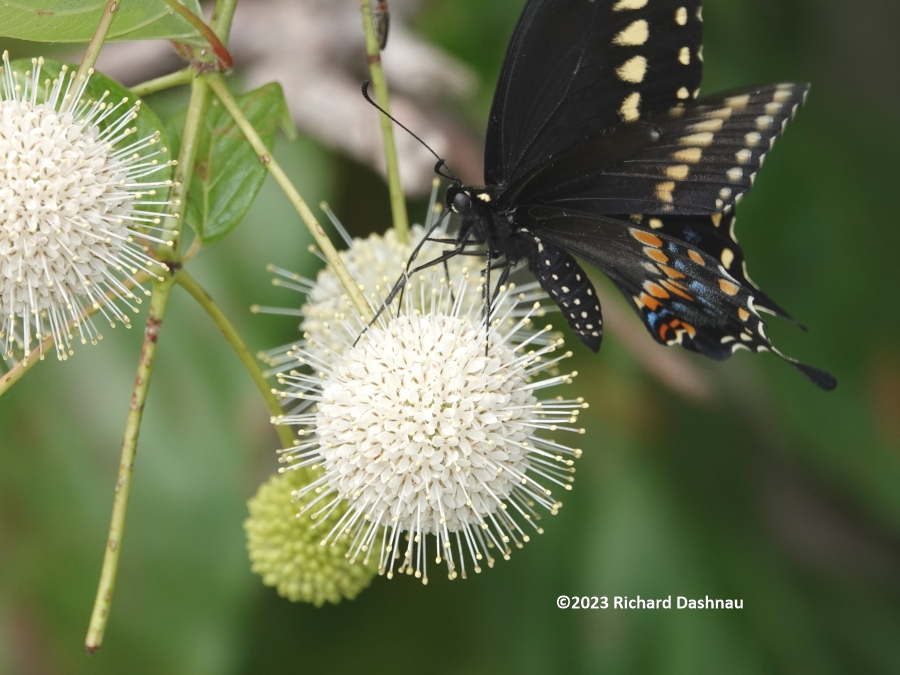
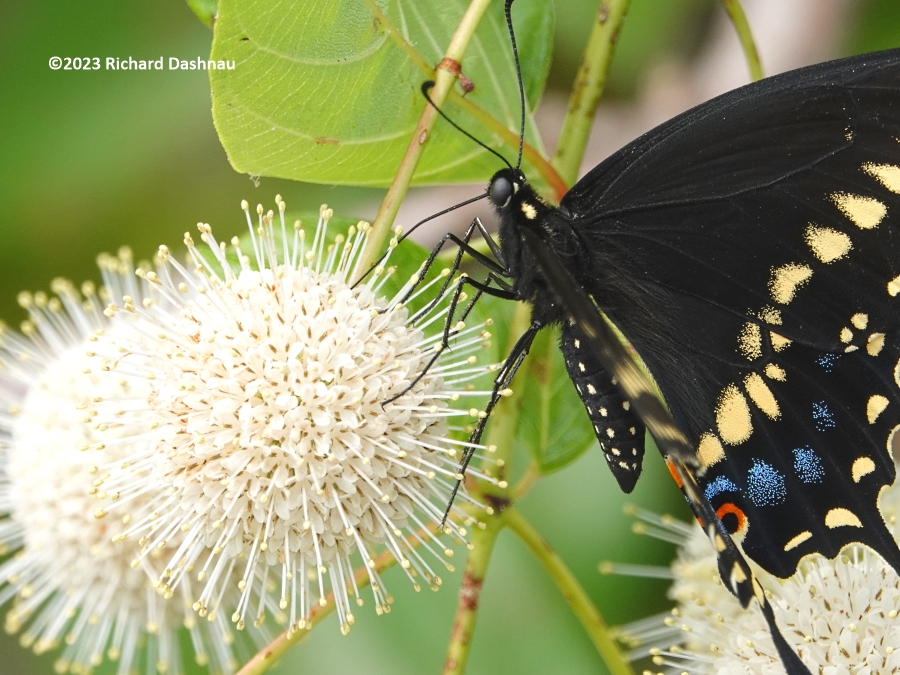
In Houston on 05/11/2022
At my exercise area, I noticed another mud "cast" on the dirt
trail.
This time, I thought I knew what it was (because of what I'd
seen a week
ago), so I got the camera before investigating. I pulled
up
on the "plug" and uncovered another cicada nymph burrow. Click
the
link for a short film that includes some of these photos
as well as some video clips.
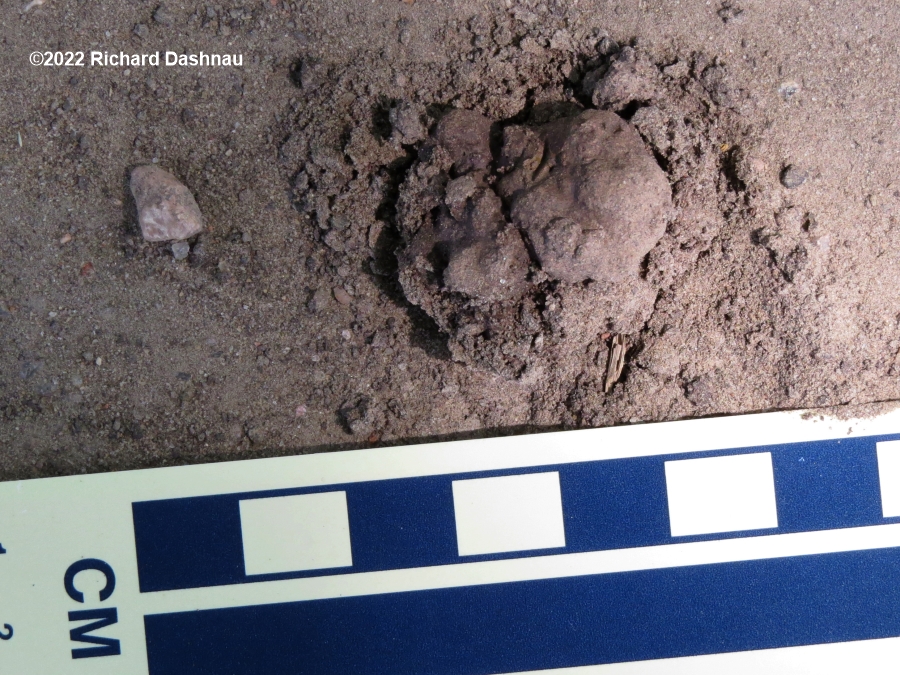
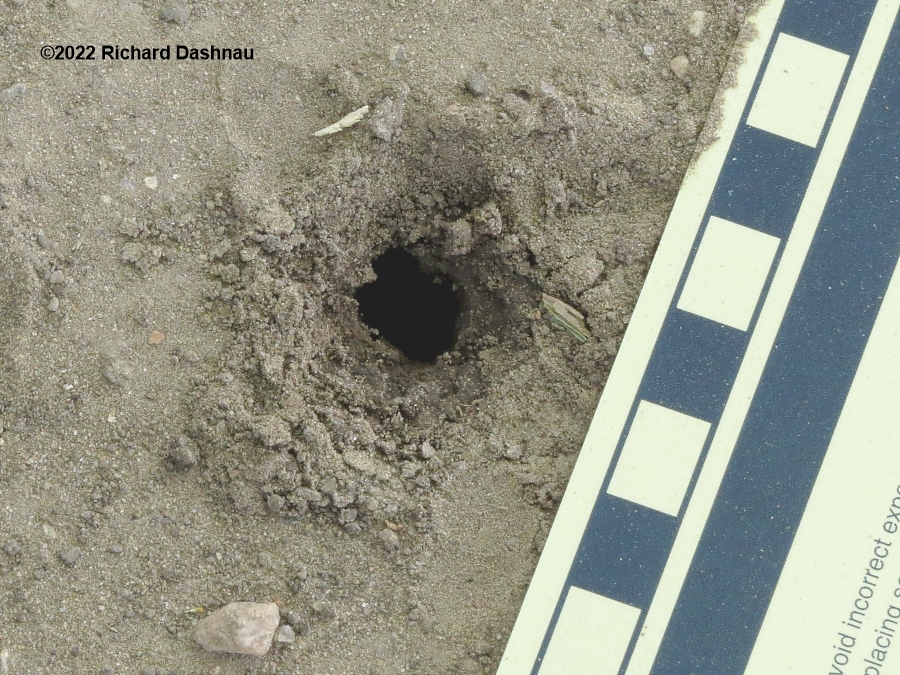
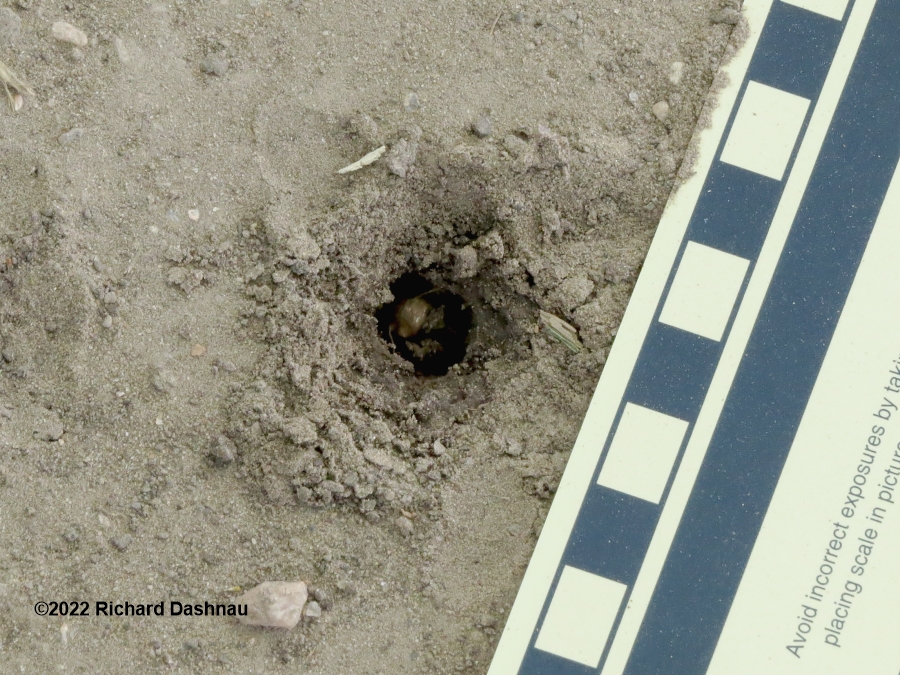
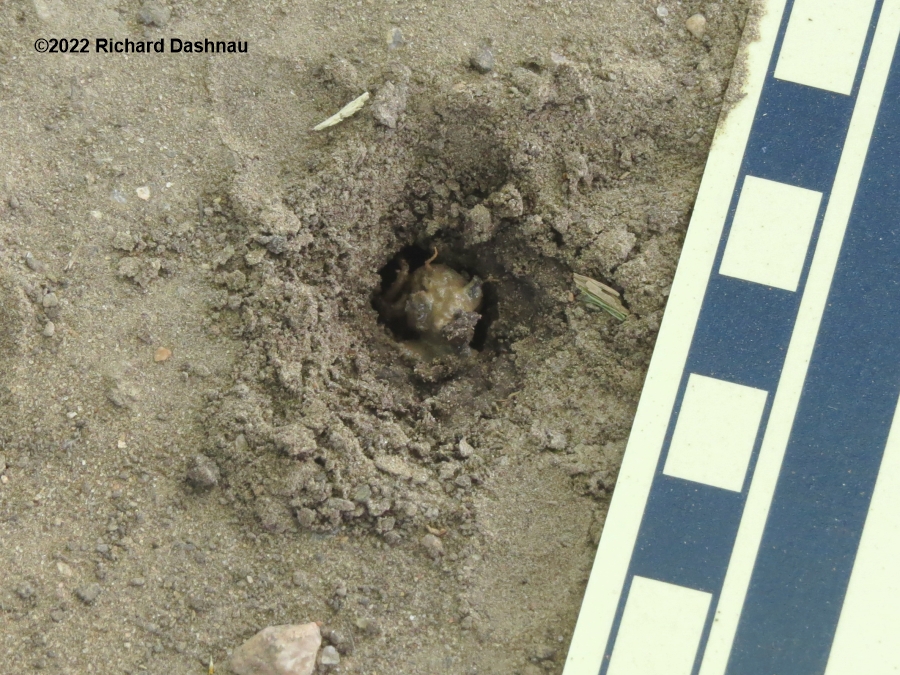
About 5 minutes later, a
cicada nymph showed its face, and started
applying
a paste to the edges of its hole. As with the previous nymph,
this one
withdrew, then returned a few minutes later to add more paste
to the
edge of the hole. I replaced the plug
and left something near it so I wouldn't step on it, and
started my exercises.
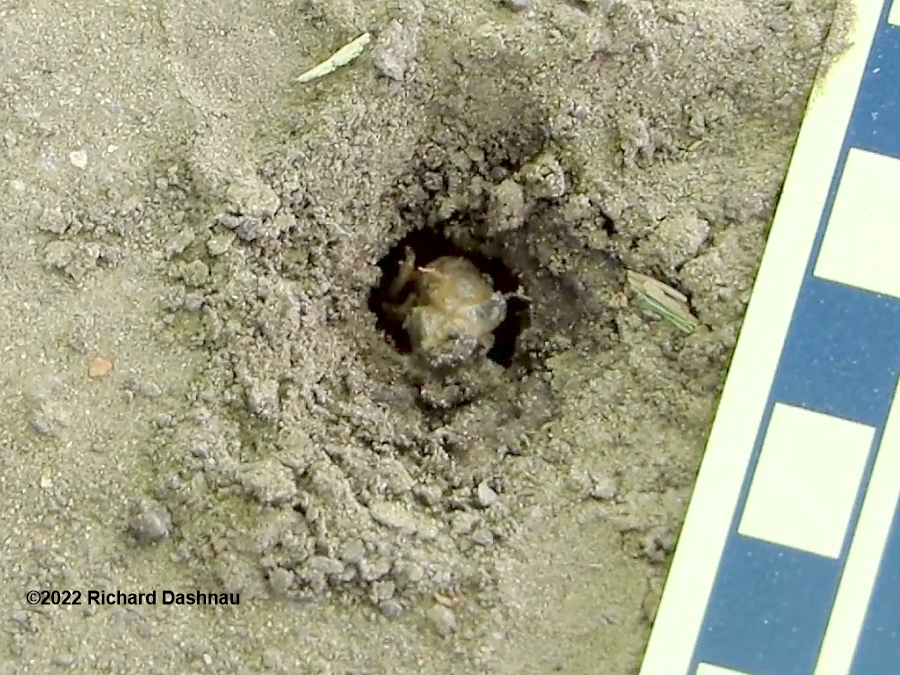
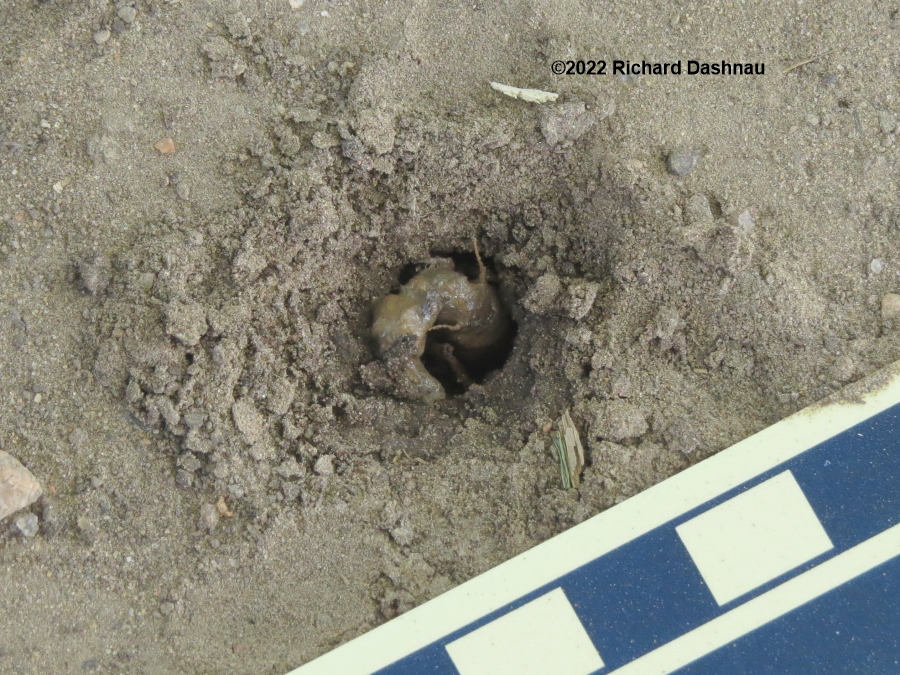
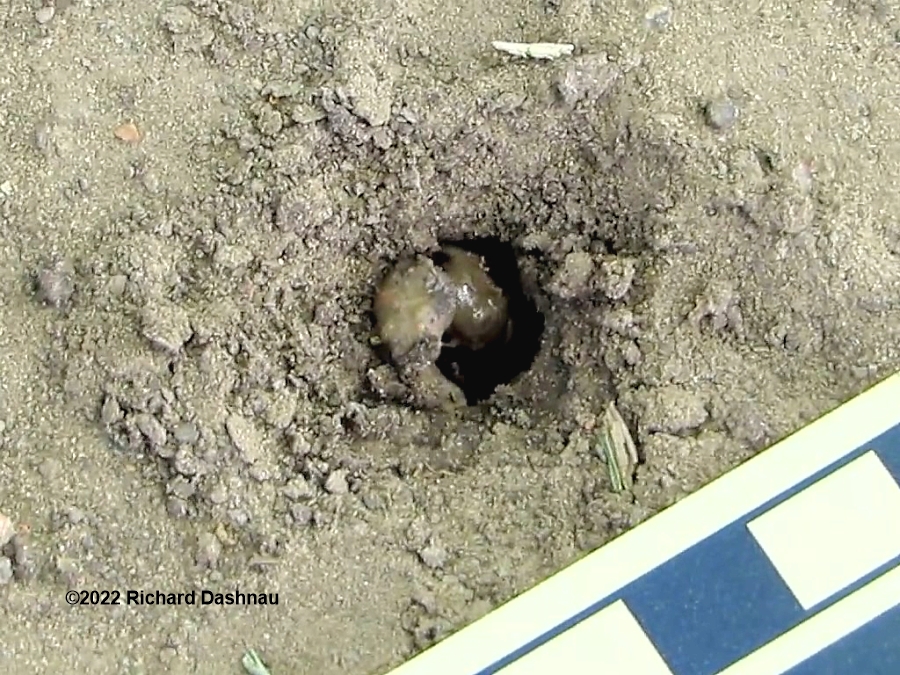
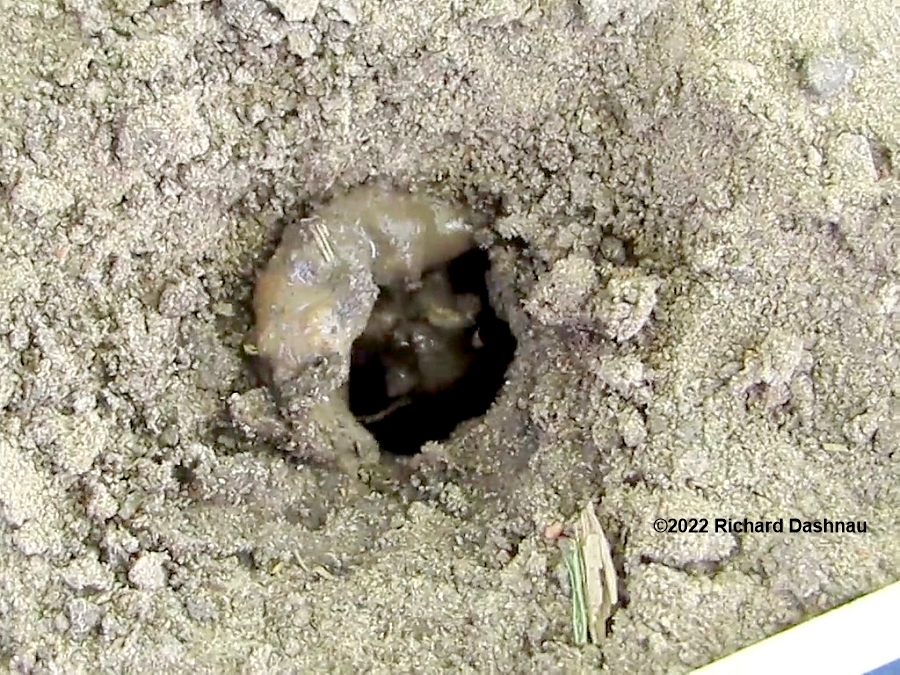
This
is the second time I've seen a cicada nymph produce
"paste".
I figure
that it's partially-composed of dirt; but what is the
moistening agent?
The ground was dry, and I don't think there
was "mud" just a few inches
down. Do the nymphs secrete liquid? If they do, what is
it--water,
mucus...something else? How much can a nymph produce?
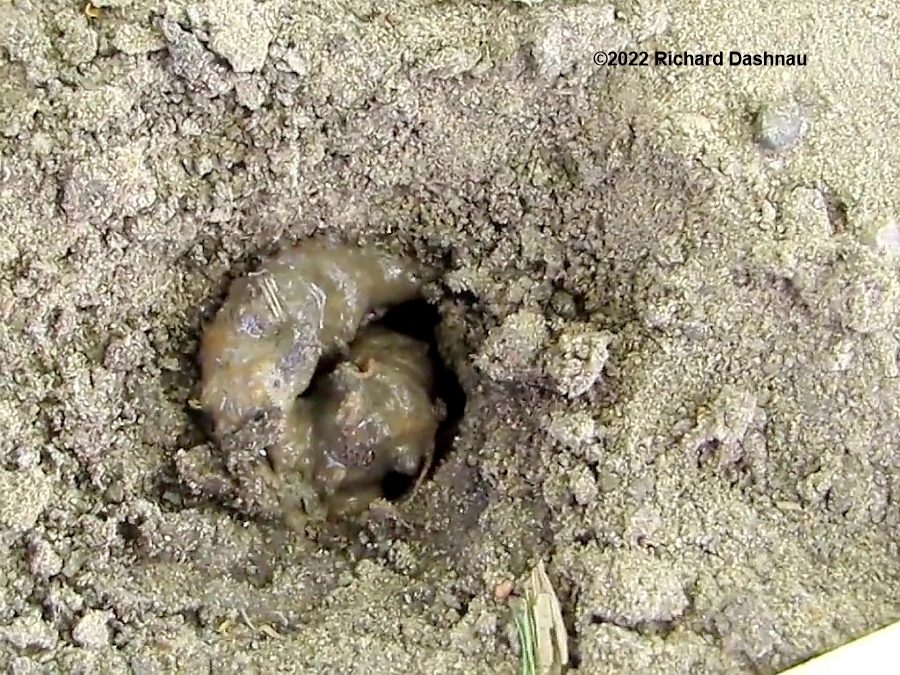
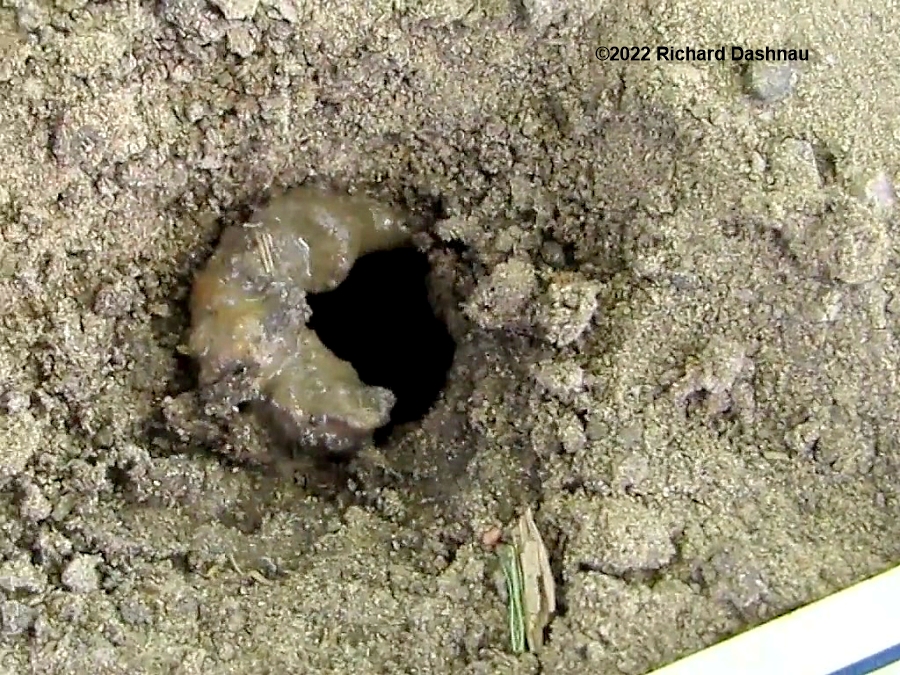
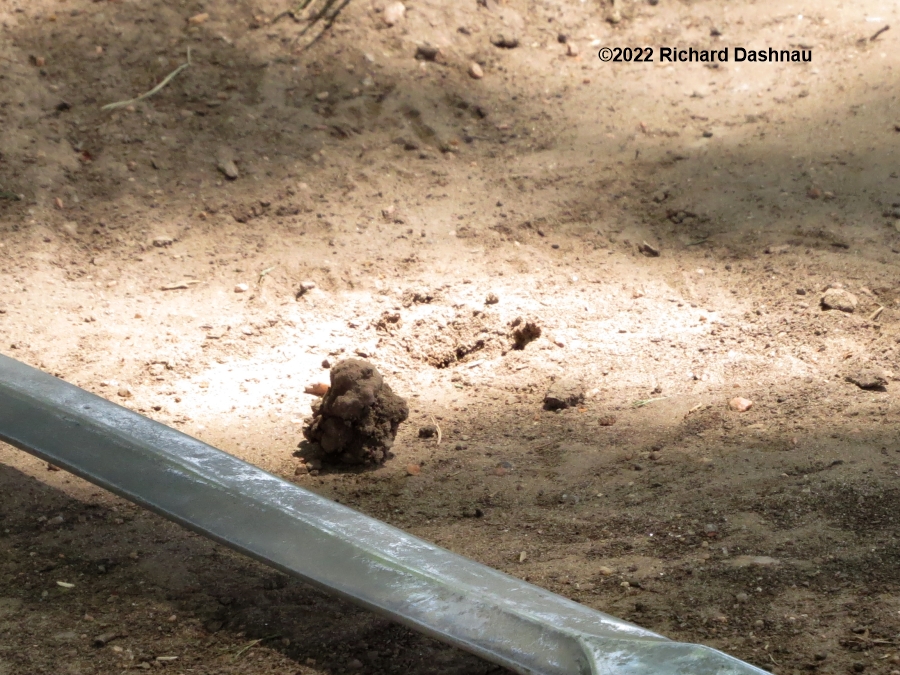
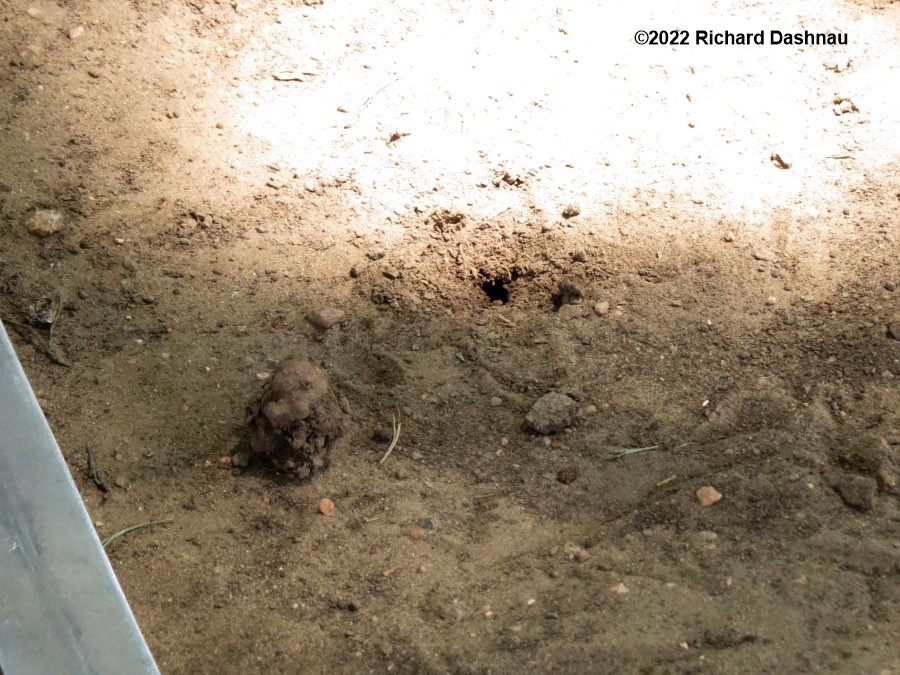
About
20
minutes later a Great-Tailed Grackle (Quiscalus mexicanus)
landed
nearby (as they often do while I'm working out), and began
foraging. I
happened to be looking at it when it
noticed the "cicada plug" and
moved towards it. My camera was on the ground near the plug. I
moved to
the camera as the Grackle moved towards the plug and started
to pry it
up. I hoped
to capture this on film but the grackle stopped digging
moved away when I picked up the camera . So the most I could
do was
take pictures of the excavated plug. I moved around the
tree
to let
the Grackle continue, when it found another cicada hole and
started
digging at it. I got a few pictures some video, but the
grackle gave up
and walked off. This
is another
example
of Grackles recognizing
and exploiting a food source. They (or at least one of them)
recognized
a small pile of dried mud as a place to dig for food!
Exploration of an
open hole is also
noteworthy--although I think many animals explore
voids or openings in the environment. For the Grackle to
recognize that
the pile of
mud was different and worth investigating seems
pretty
cool.
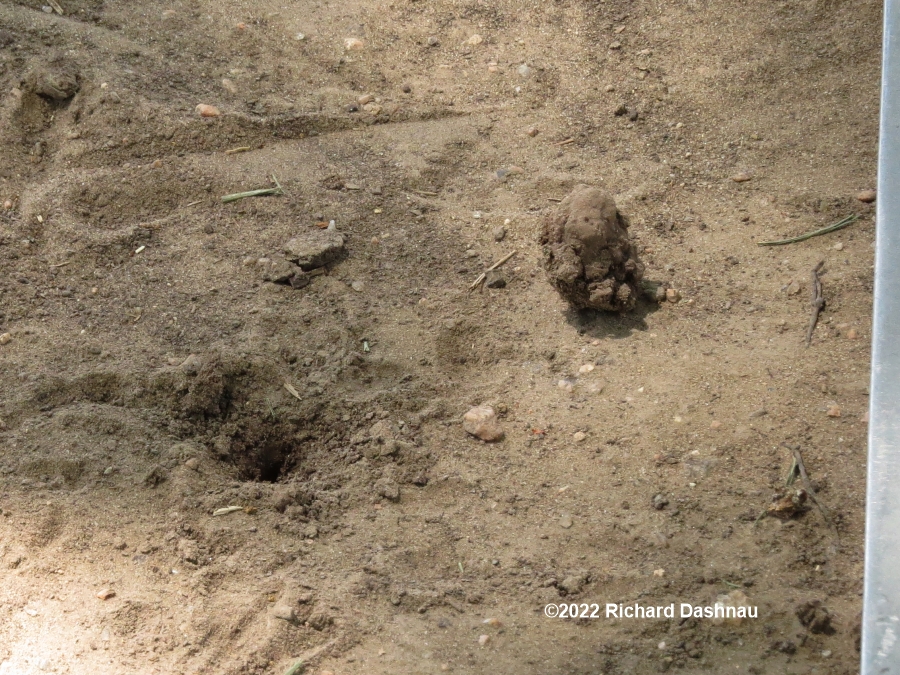
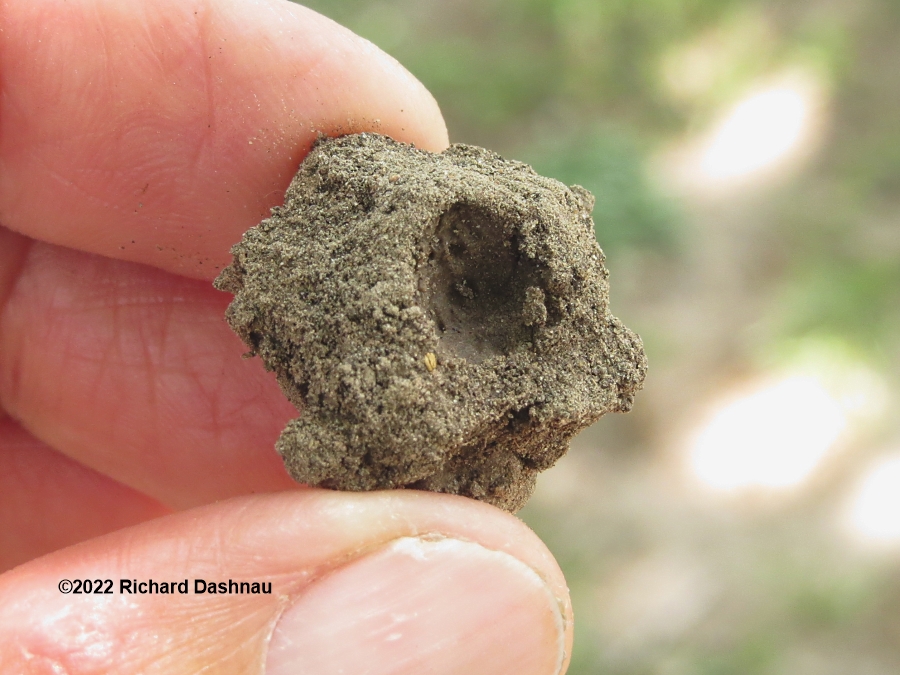
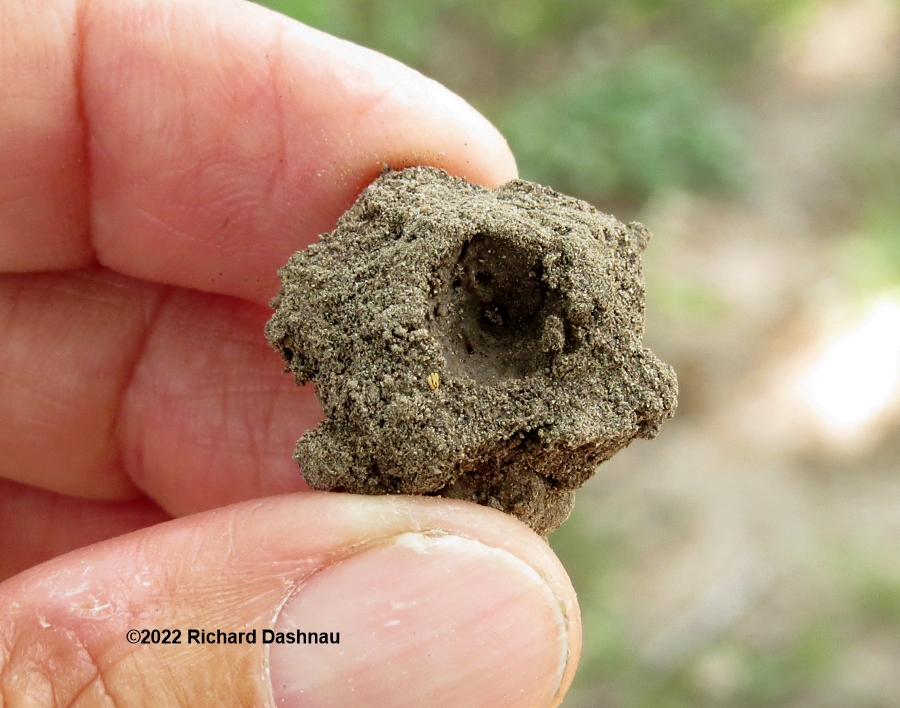
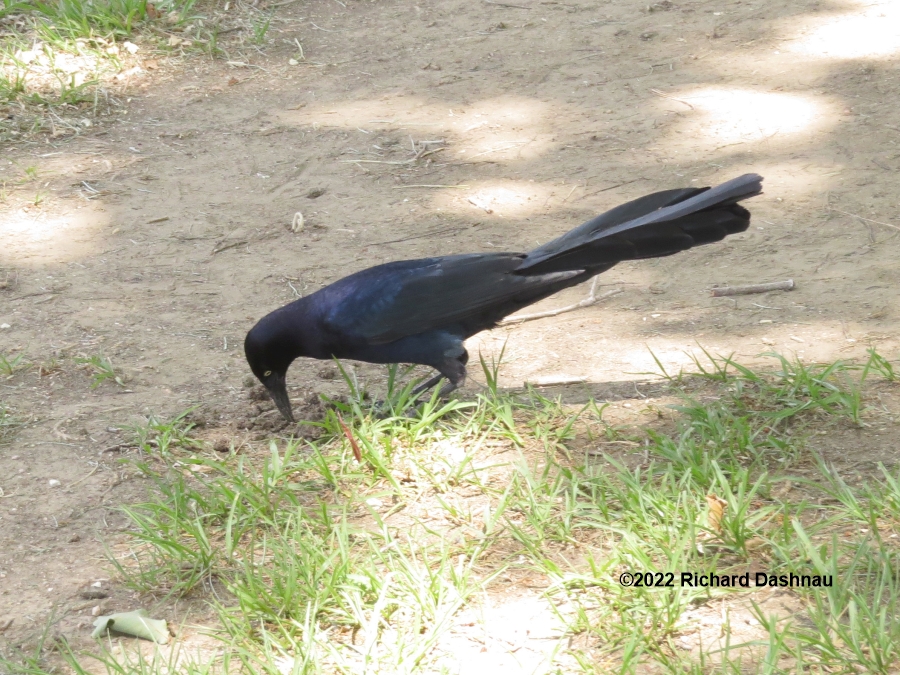
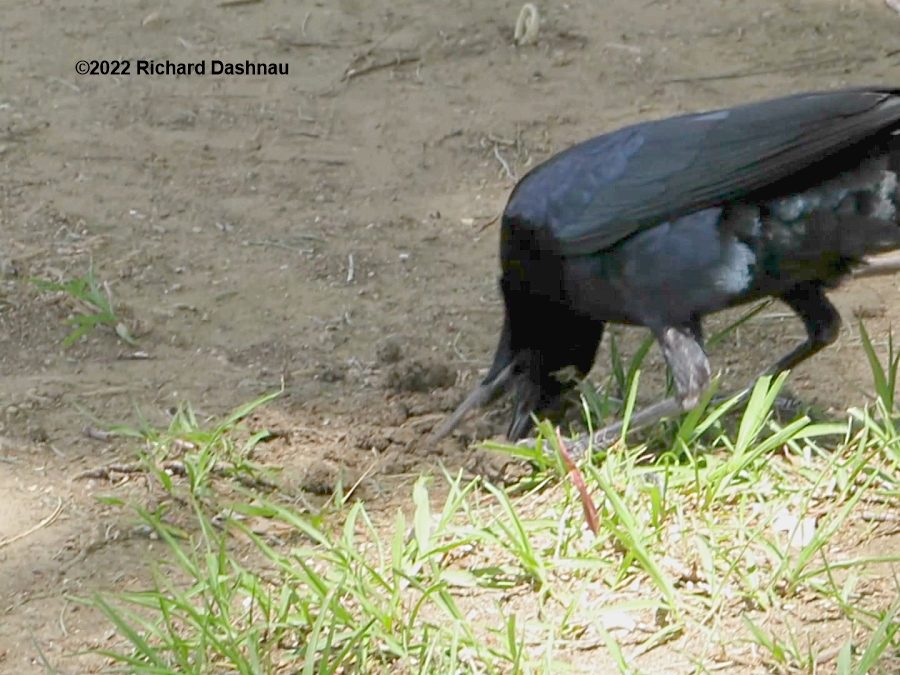
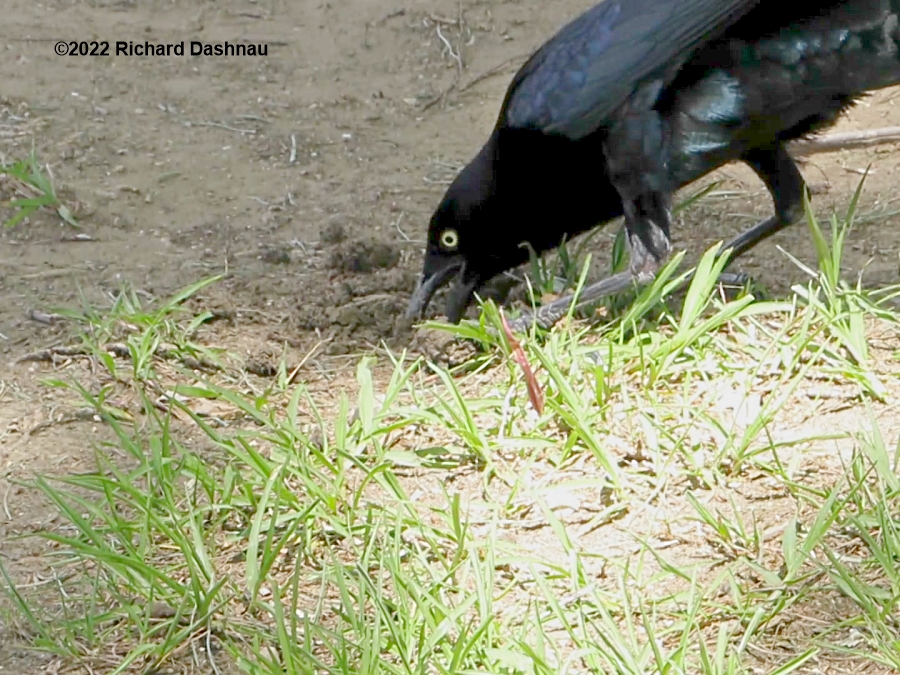
From Houston on 05/02/2022.
I was checking my exercise area for stones and poop when I
noticed this
lump. I didn't want to step on it for many reasons. I could
already
tell that it wasn't poop, but thought it was a burrow casting
of some
kind. When I picked up the lump, what I uncovered was so
interesting that I put lump back, then delayed my
exercise to
run back to the car and get a camera. Then I lifted the mud
lump again.
The hole looked like a cicada burrow (I often see them
here).
But
the fabricated mud cap had
confused me...
...until the owner of the
burrow appeared.
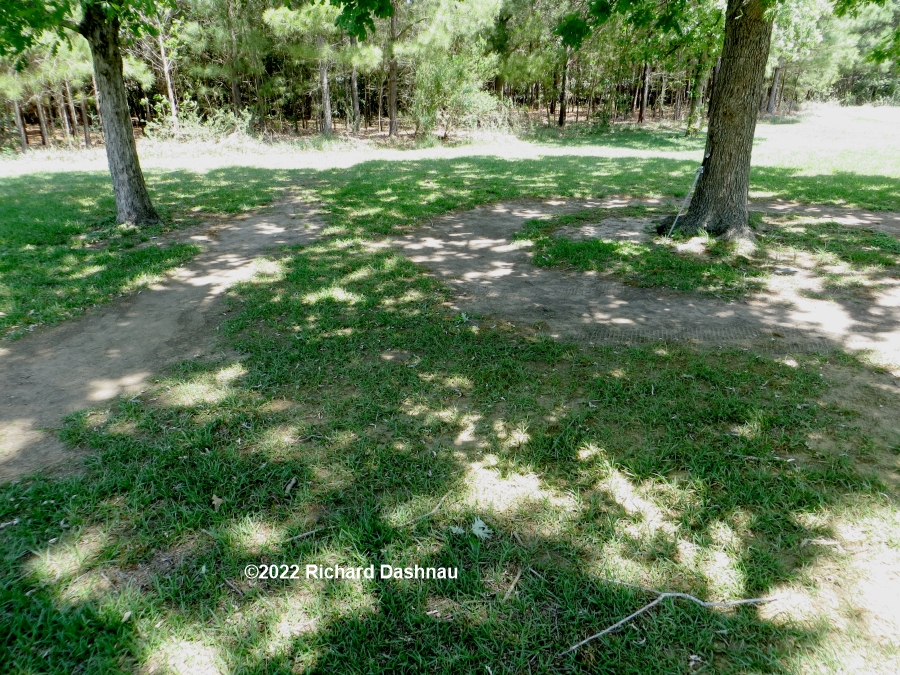
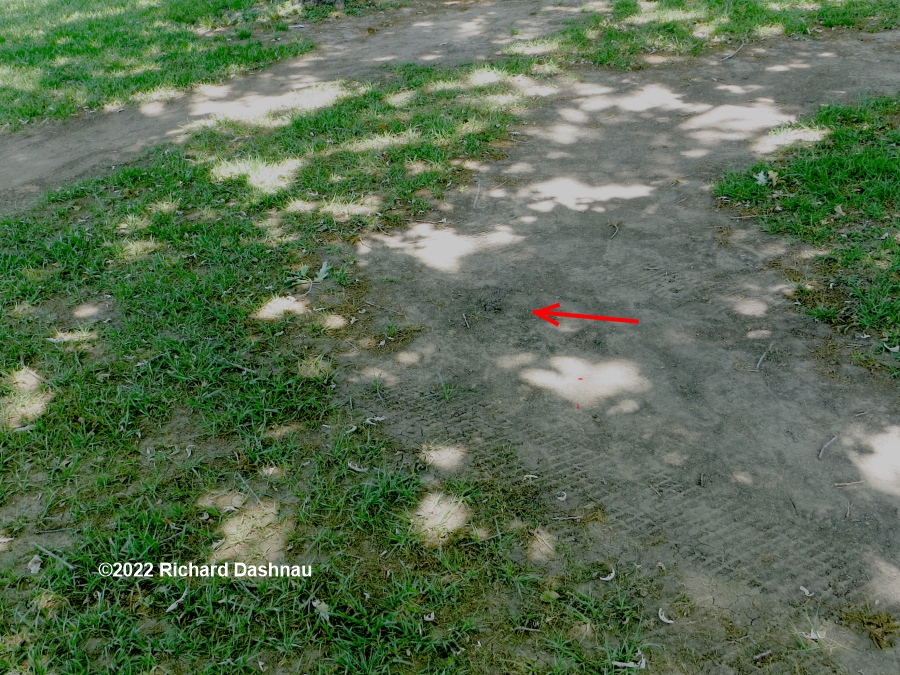
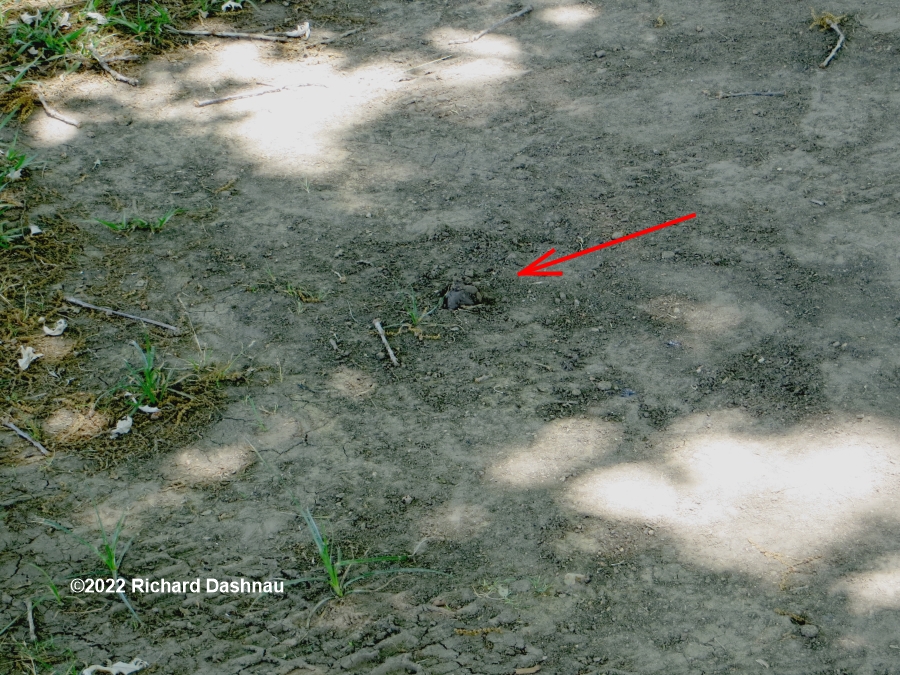
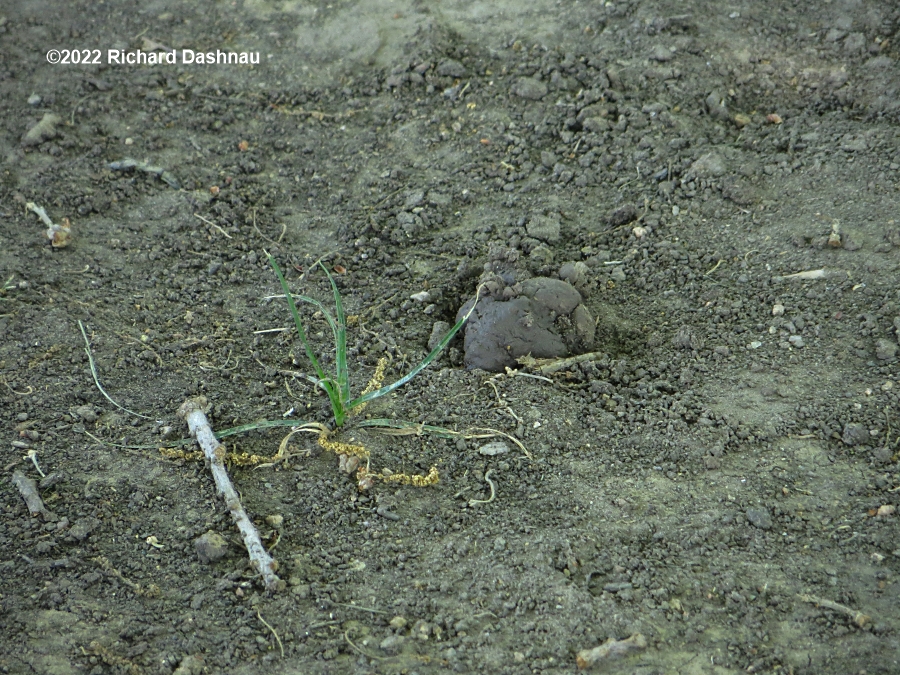
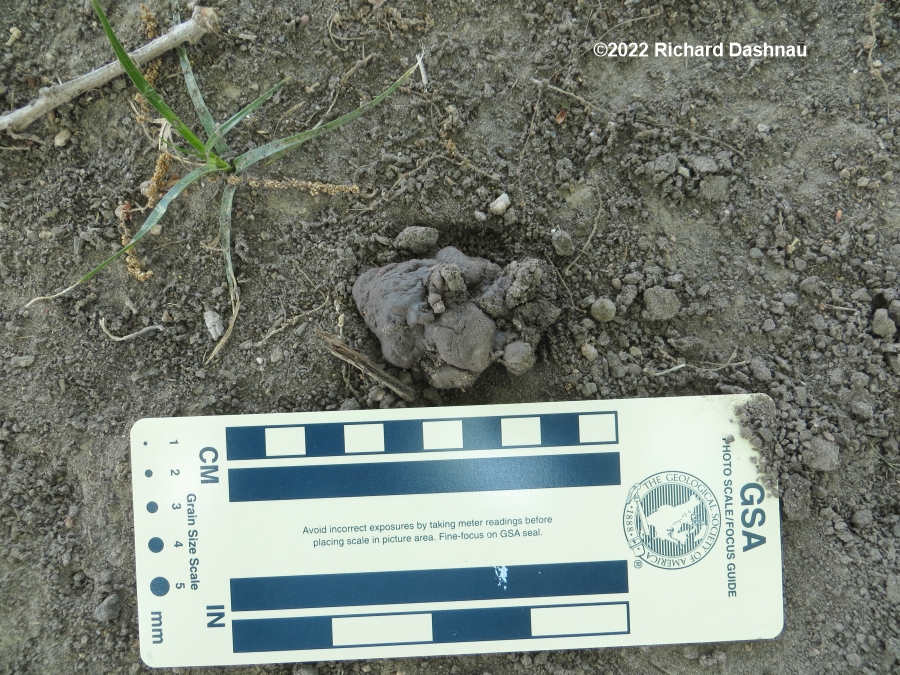
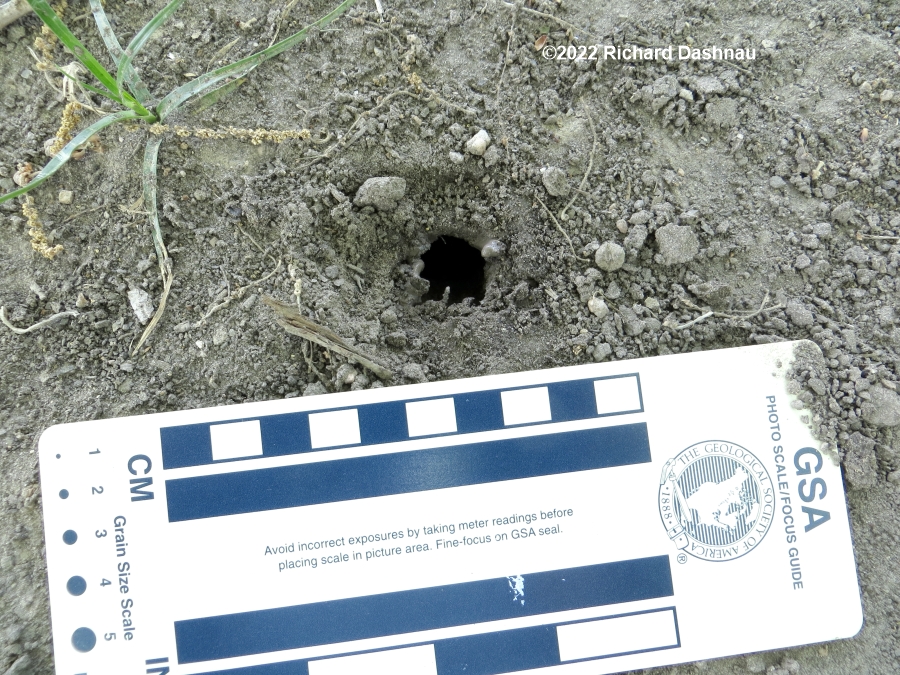
It
was a cicada nymph! Then it returned to the depths. By
the
way,
the images of the nymph below are from video I filmed
then.
You can see the
short video
here (mp4).
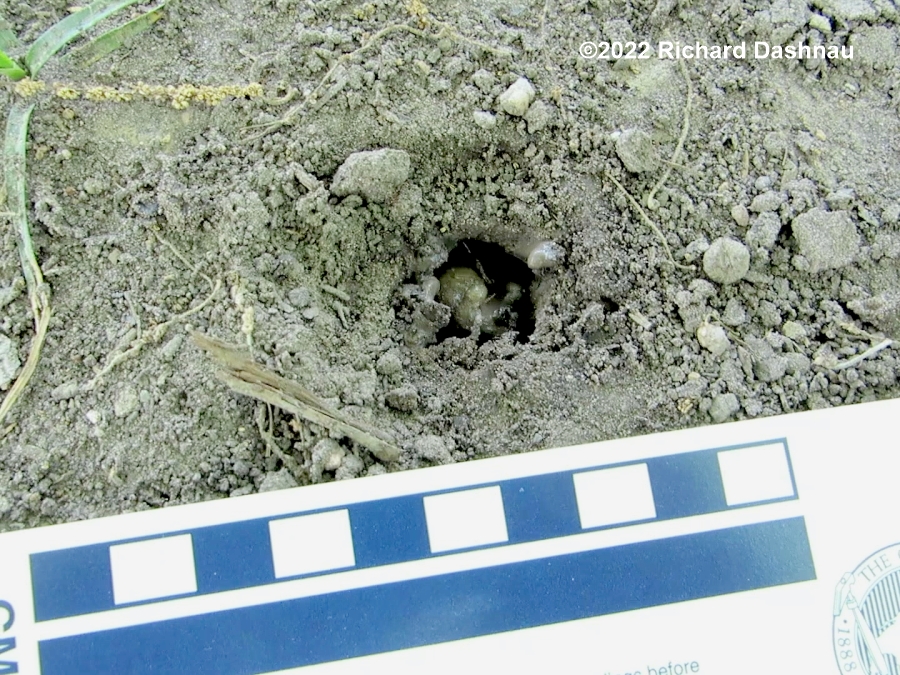
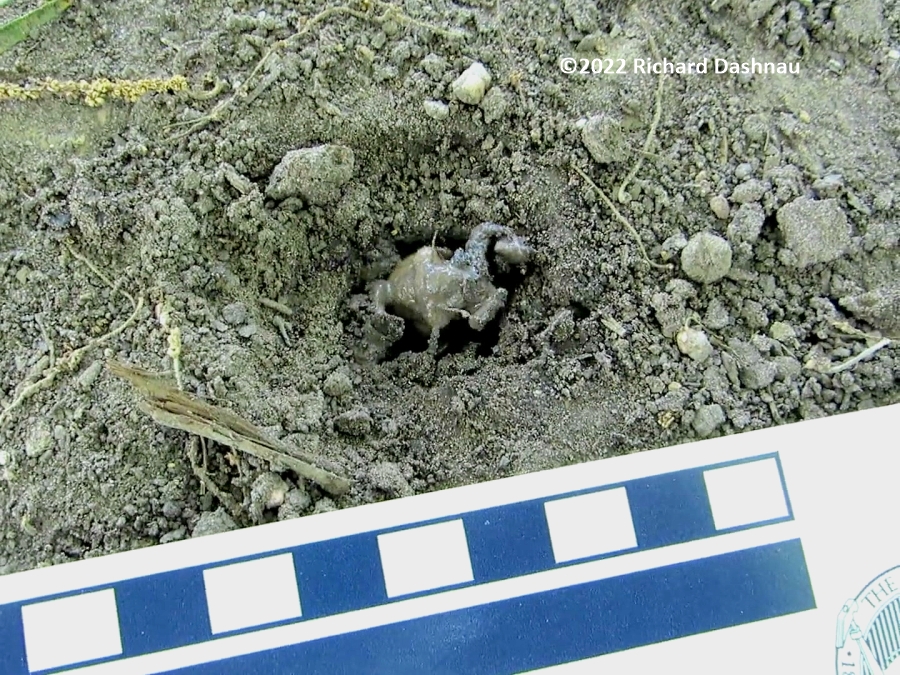
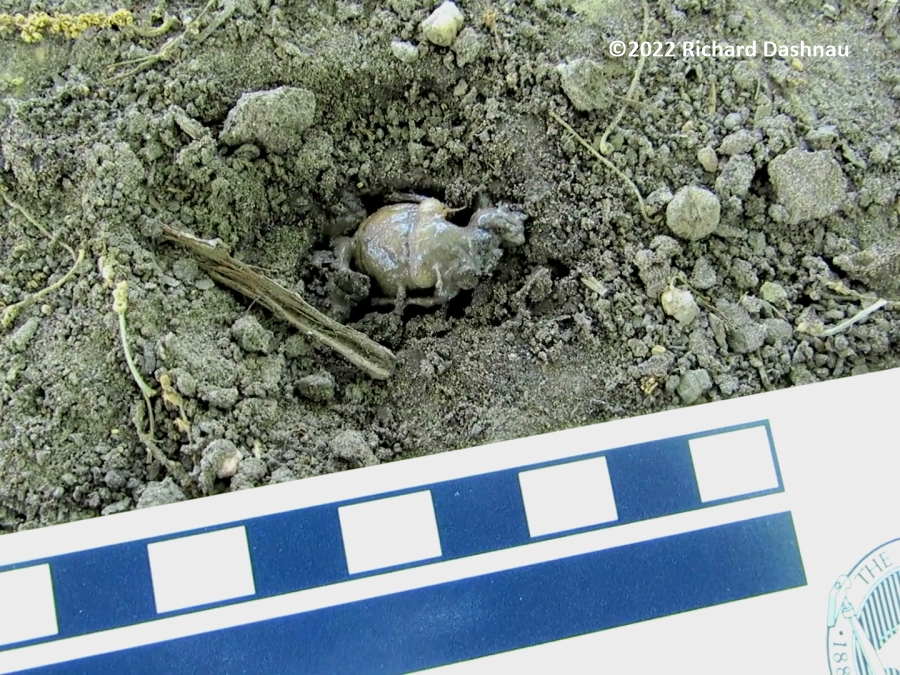
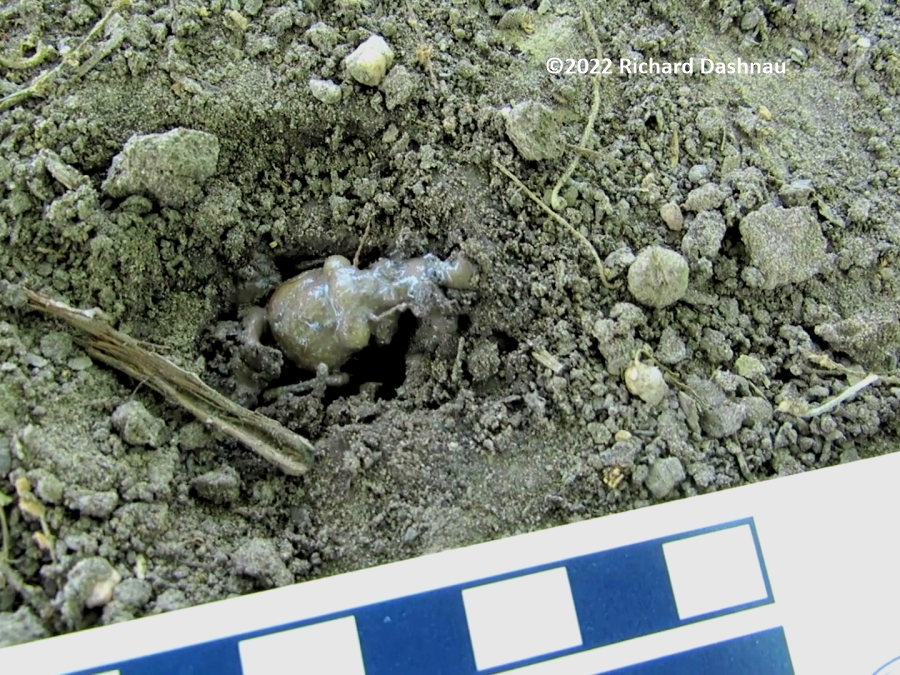
I
waited a while, and it made another trip. I've seen many
cicada
burrows-here, and at other places. But this behavior was new
to
me, so
I did research after I got back home. Cicada
nymphs sometimes make a
chimney, turret or a cap over their burrow while waiting to
emerge! I
saw pictures online of some turrets that resembled small
versions of
crawfish chimneys.
Type
"cicada chimneys" or "cicada turrets" into your favorite image
search
and you'll see what I mean. This really surprised me.
I'd
just
assumed that the nymphs came out of the ground
when they are ready
to do their final molt, climbed up, and did their final "pop".
But
apparently sometimes they "wake up early", hit a snooze button
and go
back underground for a while.
I was also reminded by many
references to how Copperheads like to hunt for emerging
cicadas--and
possible increase in numbers of Copperheads during Cicada
emergent
times.
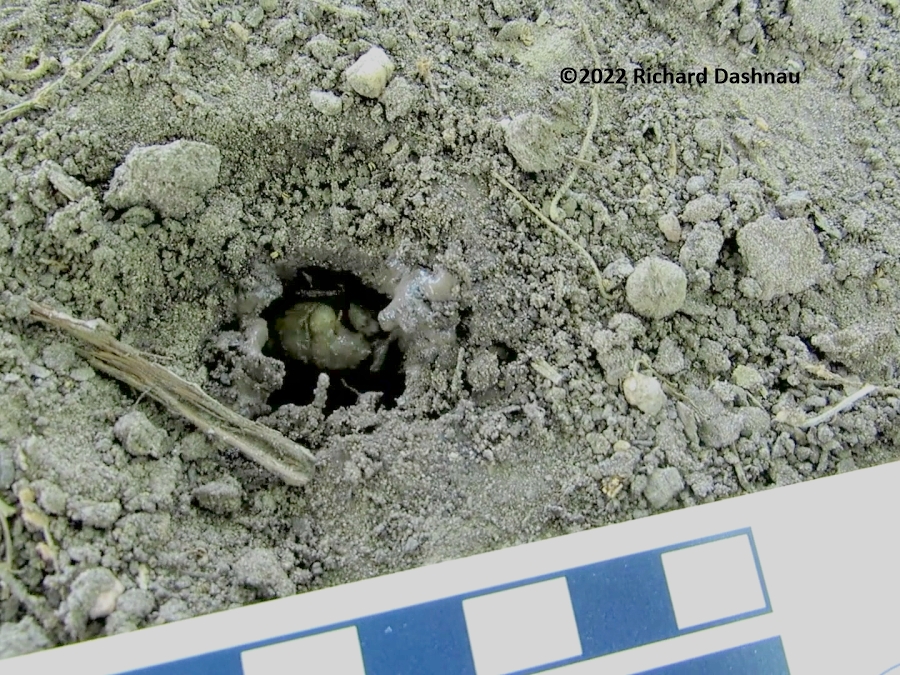
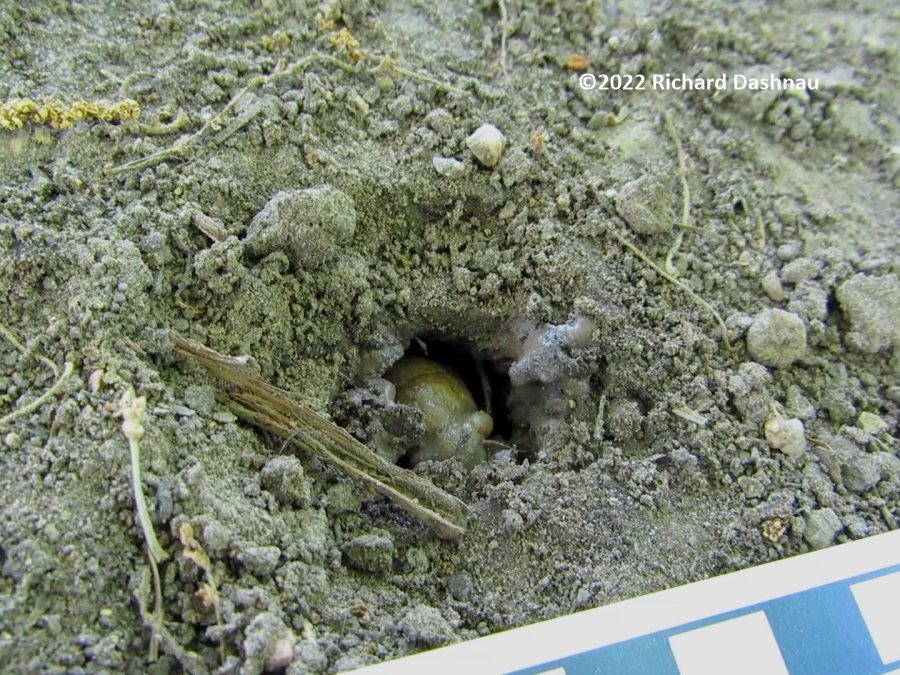
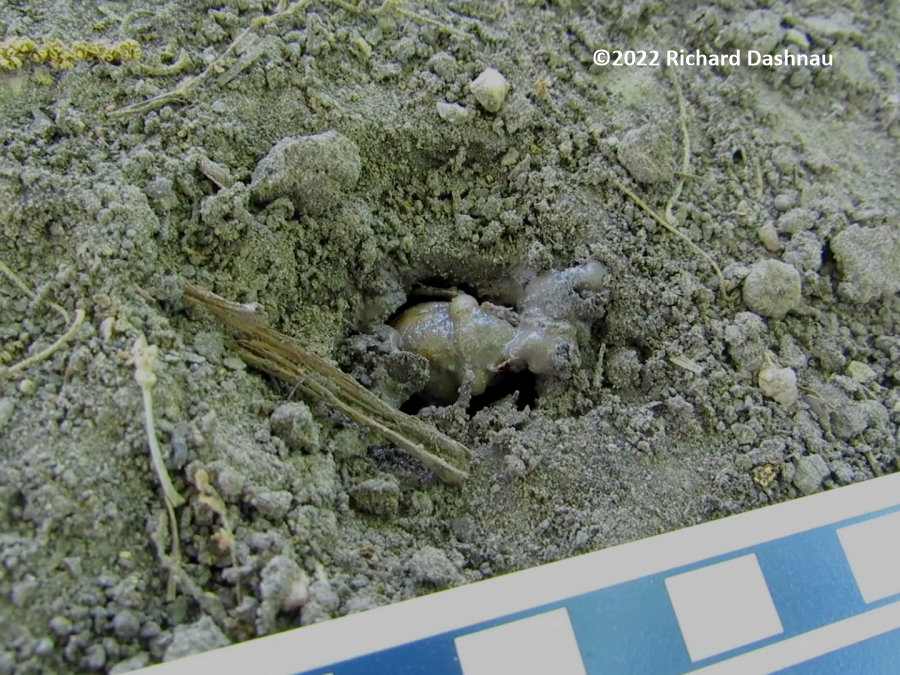
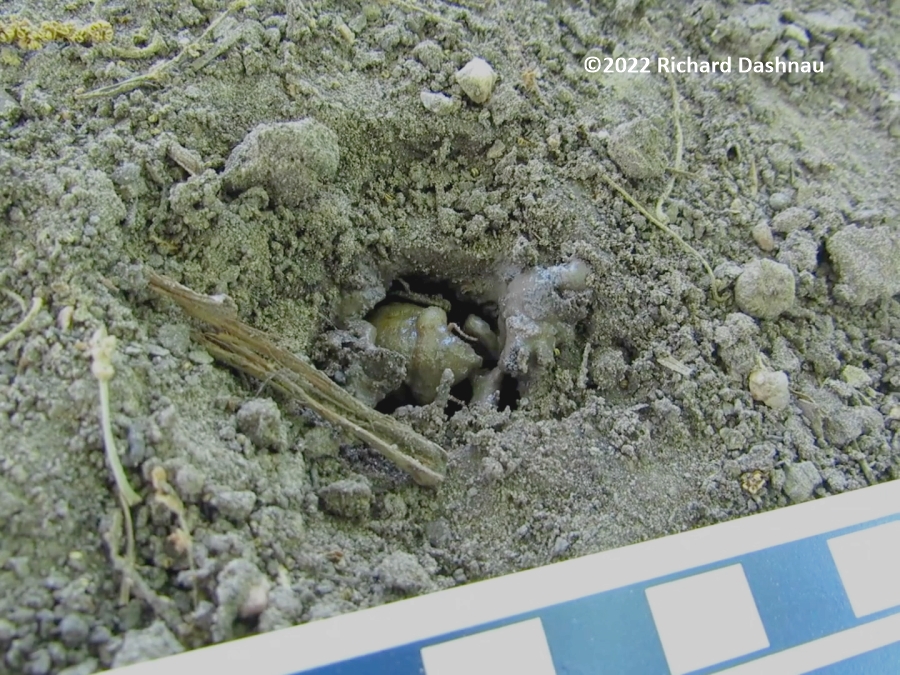
This
is the underside of the cap that I removed. It was hollow on
the
bottom. I put the cap back over the hole. Note how dry
the
dirt
is--the cap had not been"glued" to the loose dirt .
I put my tripod over the hole so I wouldn't disturb it
further when I resumed my exercises.
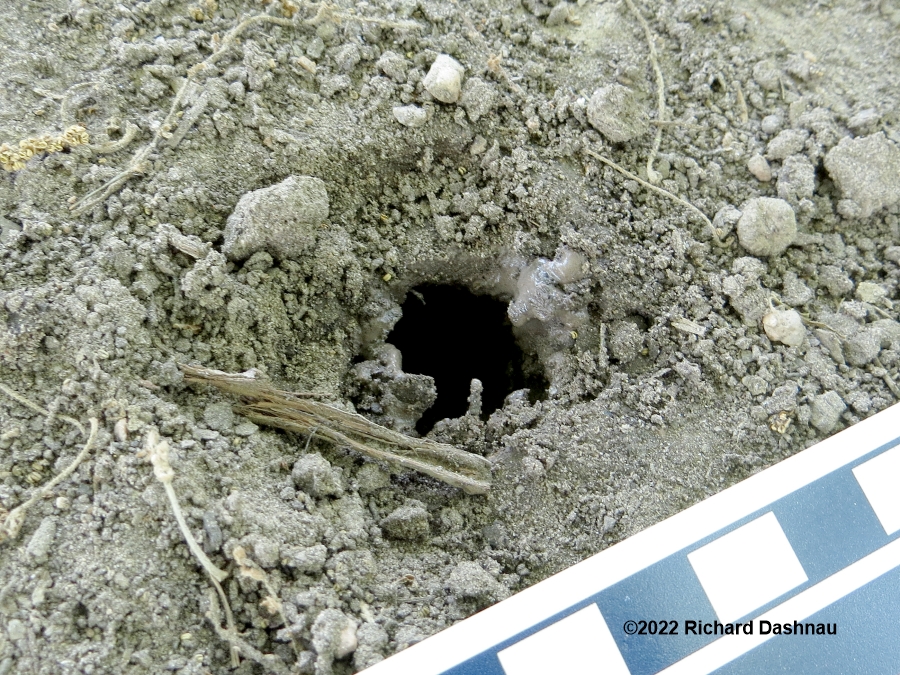
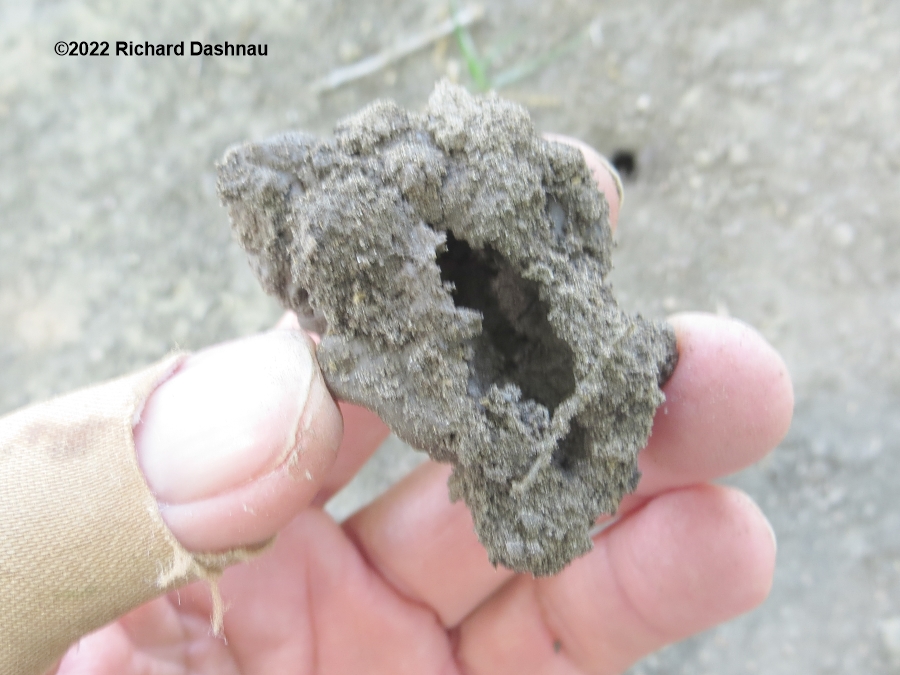
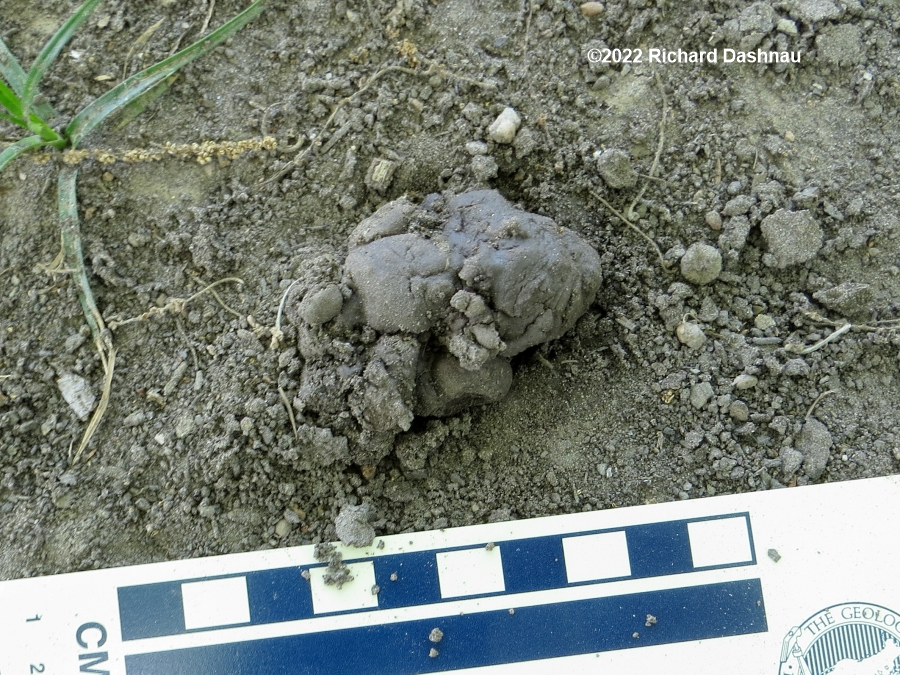
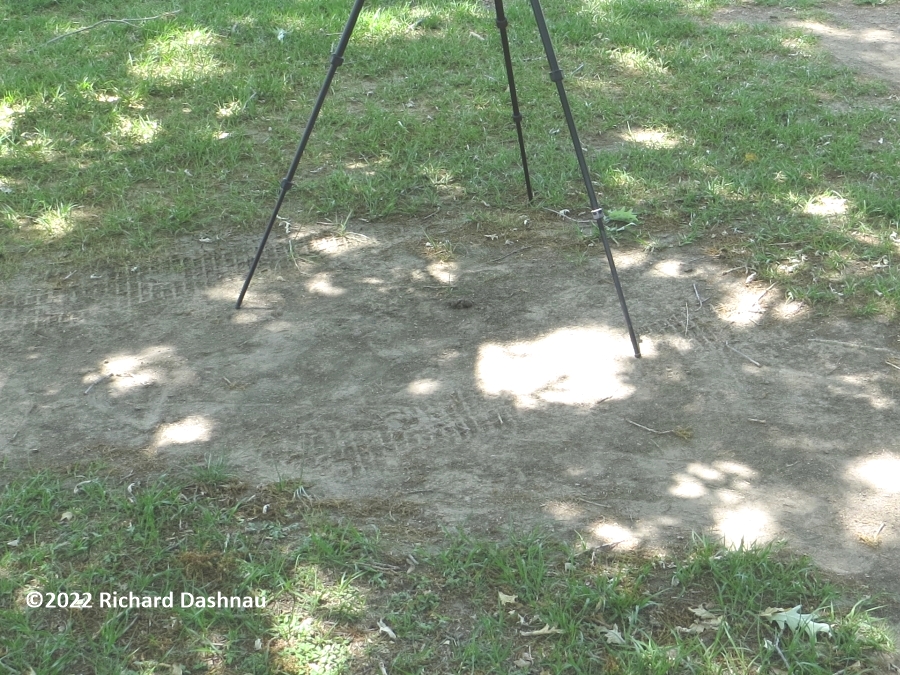
06/17/2021
As
I was walking my dog this morning, I found this cicada nymph on
the
sidewalk. Since I was nearly back home, I carried it back with
me-to
save it from getting stepped on, or
eaten by a dog, etc. I put
it on the trunk of an Oak Tree, and it climbed away. The first
time I'd
ever found a Cicada nymph (during childhood), I was very
impressed by the sharp and
formidable-looking hooked forelegs.
Back then, I assumed that what I'd found was some kind of
predator.
Many years later, I learned what I'd found, and that the
raptorial
("raptorial"
= "grasping") forelegs were mostly used for climbing. The hooks
and
points are very sharp, though,and clung easily to my skin. They
also
work well on bark. The images showing
my hand below are frames from a video I shot.
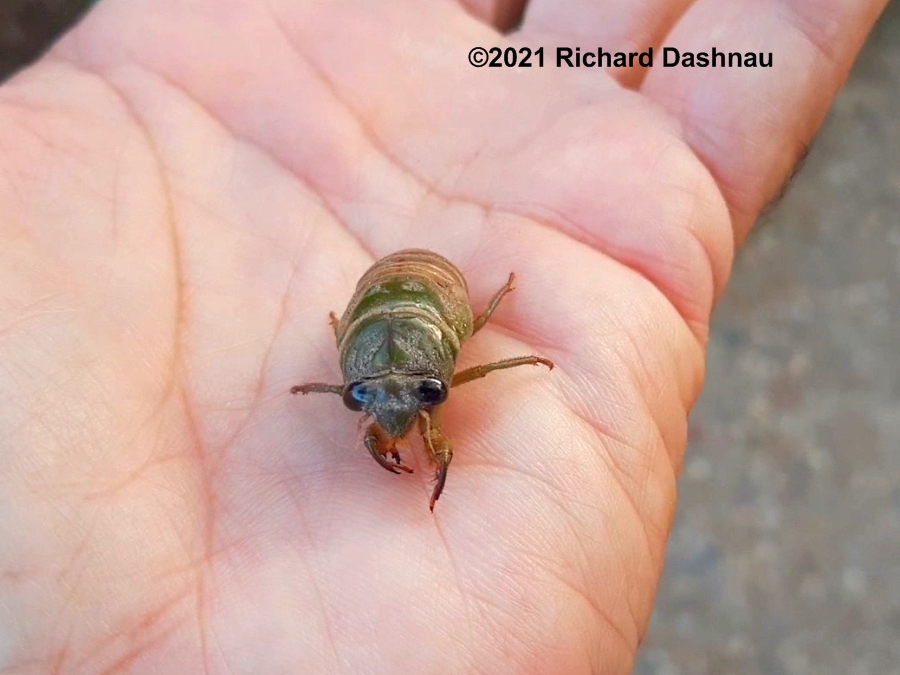
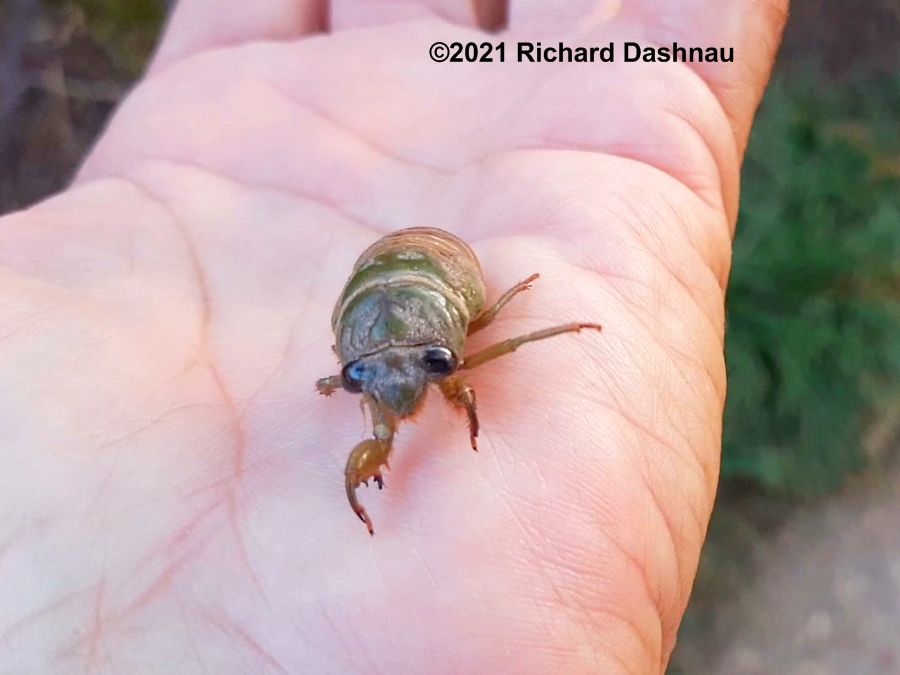
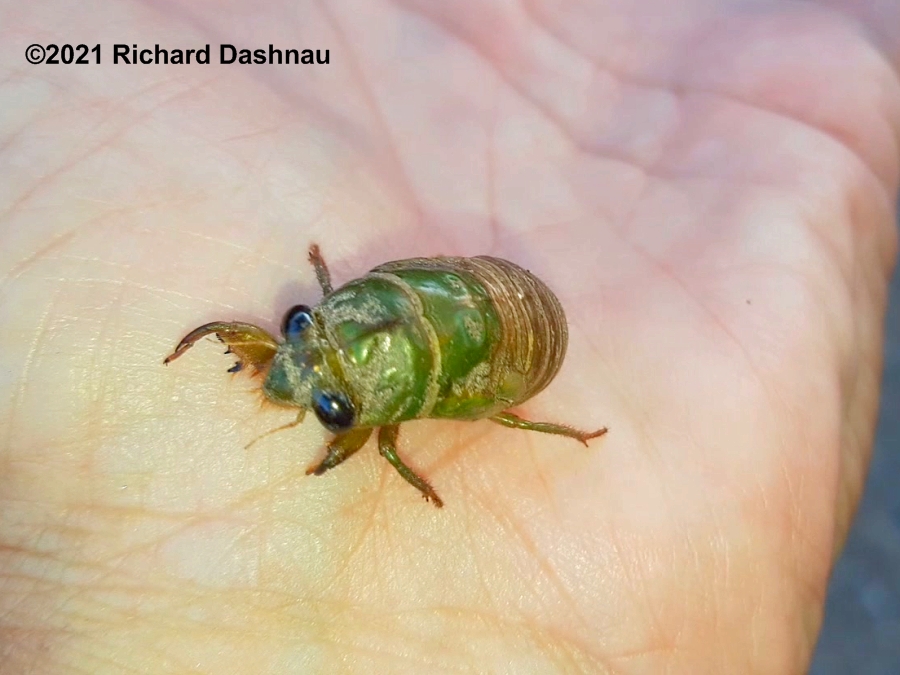
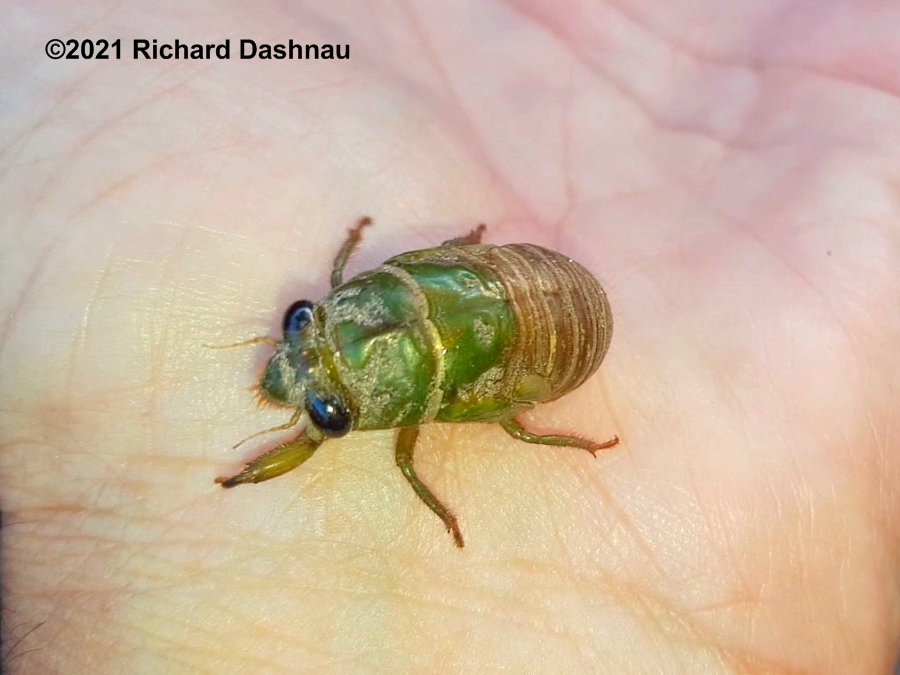
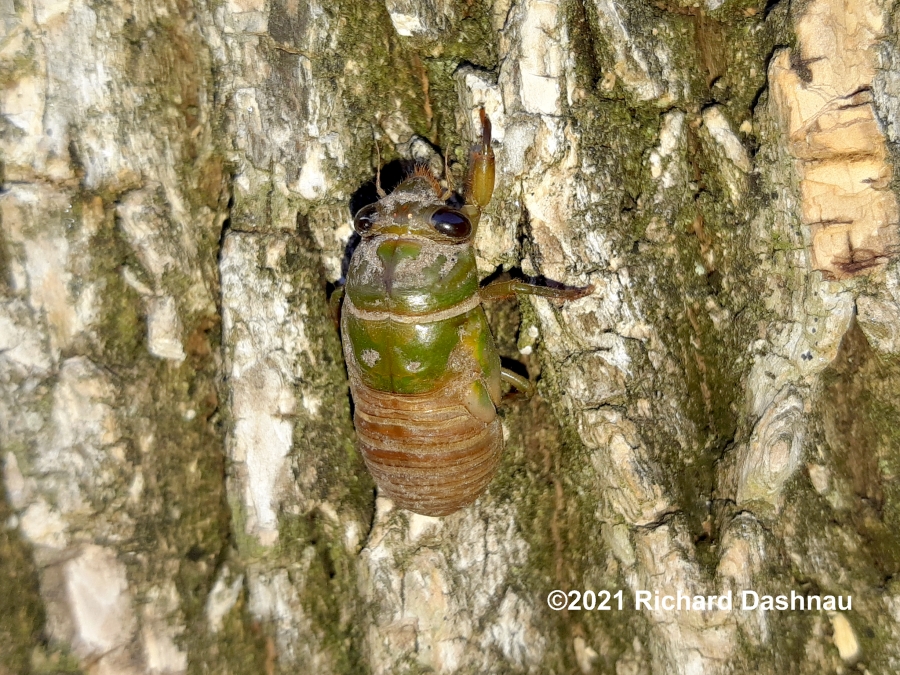
10/06/2019 Green
Darner
Dragonflies (Anax junius) are large, beautiful dragonflies.
The Audubon Society Field Guide to North American Insects
and
Spiders says they're: "2 1/4 in.
to 4 3/4 in. long with wing span up to 5 7/8 in. (p. 364)"
A
recent study: Tracking
dragons: stable isotopes reveal the annual cycle of a
long-distance
migratory insect
(Michael T Hallworth , Kent P McFarland Dec. 2018) indicates
that Green Darners migrate hundreds of miles--from the North of
North
America, to the South, then back. But...in
succeeding generations. First
generation is born in the South migrates North during the
spring
lays eggs, and dies. At the end of that Summer, some
newly-mature
adults migrate
South--though some remain as nymphs until the following spring,
when they mature and
fly
South. The 3rd generation stays in the South through that
Summer and Winter. Next Spring, that
generation matures and
starts the 3 generation cycle again. (If you can't get the
Hallworth/McFarland study, this has been summarized in a number
of
places like this one.:
https://www.sciencenews.org/article/green-darner-dragonflies-migrate-bit-monarch-butterflies
This
week, I noticed a great number of Green Darners at BBSP--maybe
the
third generation getting their last mating in before winter.
With
all of that going on, some of the Green Darners
don't make it. Some
wind up in the webs of Golden Silk Spiders (Nephila
clavipes)--like
the one below. Notice that just to the right of
the
dragonfly, there's a tiny Argyrodes spider hiding
out. This short
video
clip shows the Nephila tying her meal to her
web. I do have other images of the small Argyrodes on my web
page here.
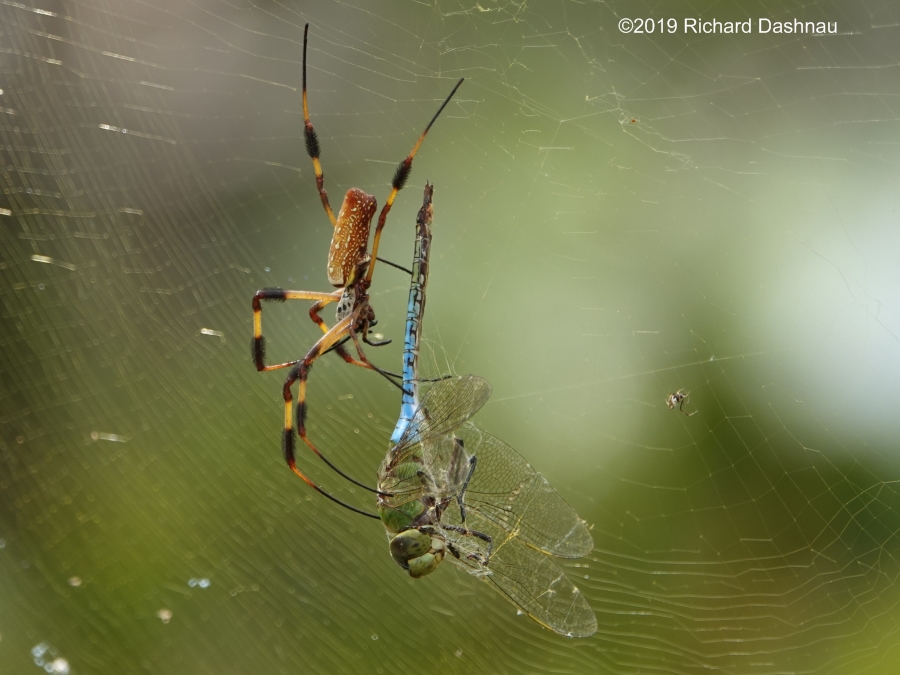
08/13/2019
As I was finishing some
exercises at Memorial Park, I noticed something moving in the
grass
towards my
exercise circle. Since the path was covered with
fine-grained
dirt, I saw
an interesting opportunity.
I retrieved my camera and took some pictures and some
video.
Then, I was able to do an exercise in ichnology.
Ichnology is
the study of animal traces. It is
commonly used in relation to
paleontology; so sometimes "neoichnology" is used to refer to
traces
left by living (extant) animals, and "paleoichnology" for fossil
traces. Three elements can
produce a trace: substrate (the
recording medium i.e. mud, sand, etc.), anatomy
(physiological
structures), and behavior (what the animal did while leaving the
trace). I don't have a good
eye for identifying a trace, but in
*this* instance I could watch it happen. So, the 4 images
below show
the tracks-of course, after the animal crossed. From left
to
right, I enlarge the view.
My camera tripod shows scale.
Its an oddly-assymetrical trail.
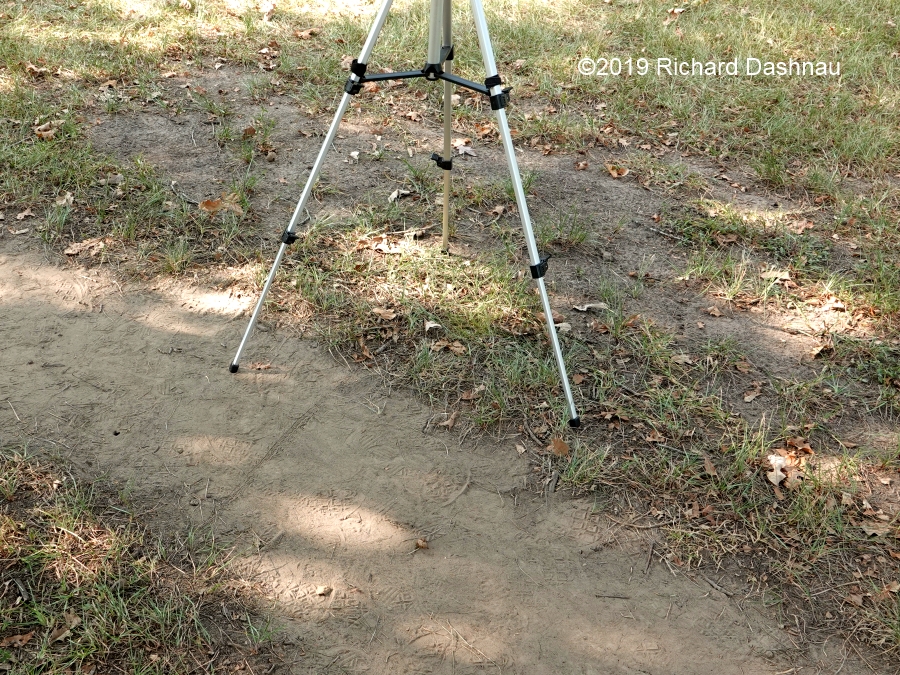
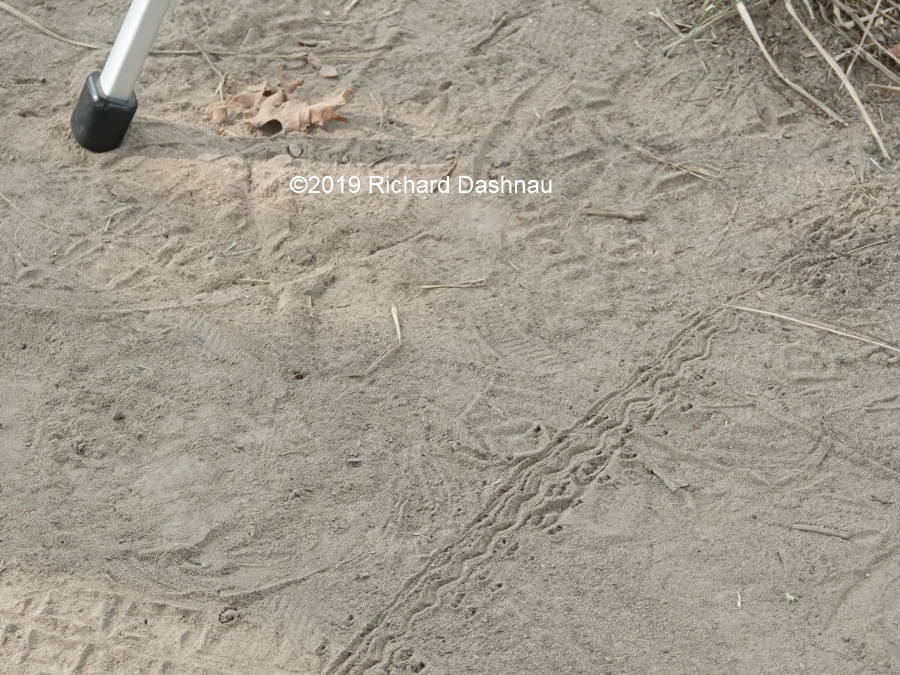
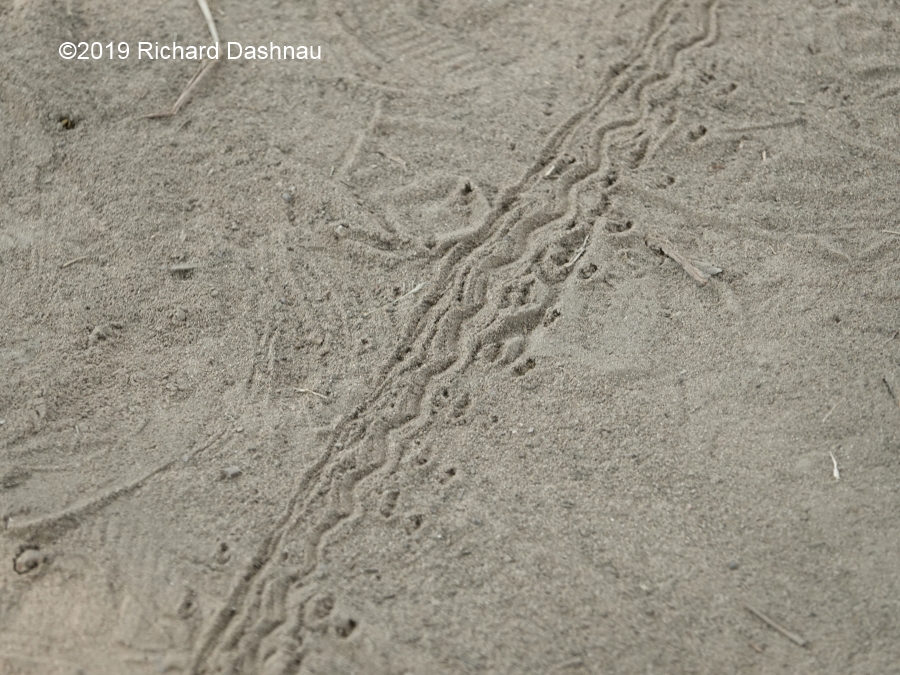
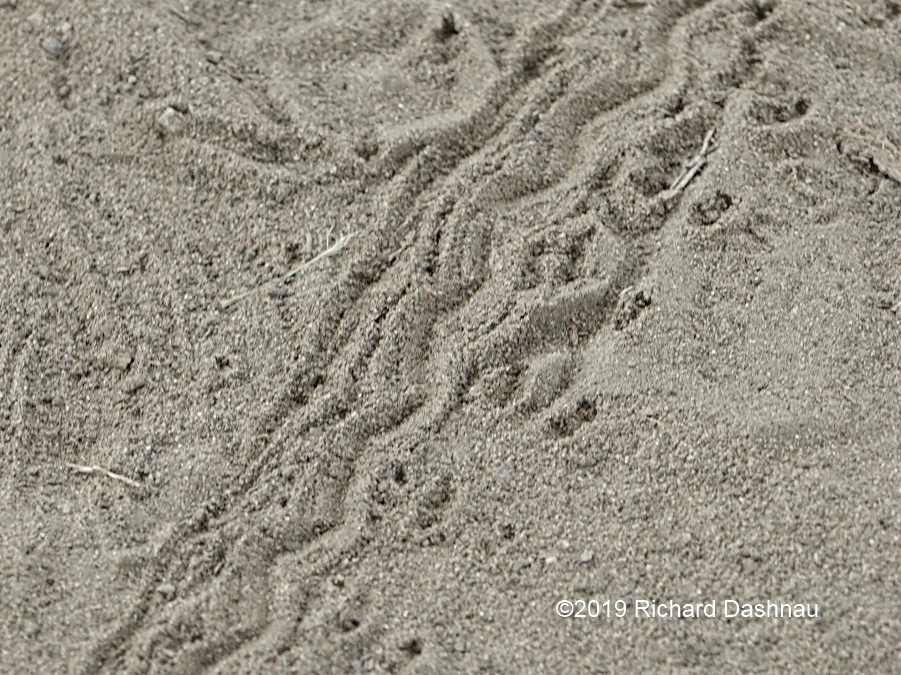
The four images below are from the
video
clip, and they show the track maker as it made the
tracks.
The
culprit was a larval cicada! It had come out of the ground
and
was looking for something to climb upon so that it could
complete its
tranformation into an adult.
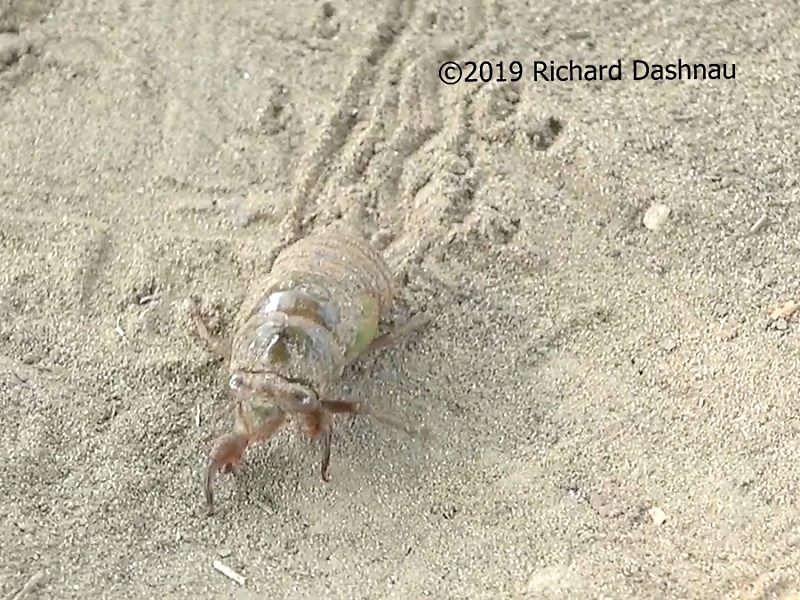
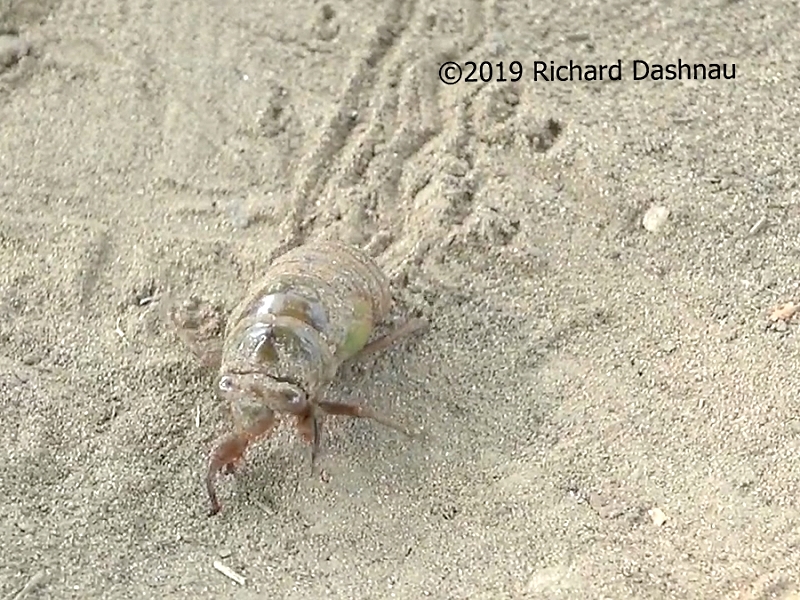
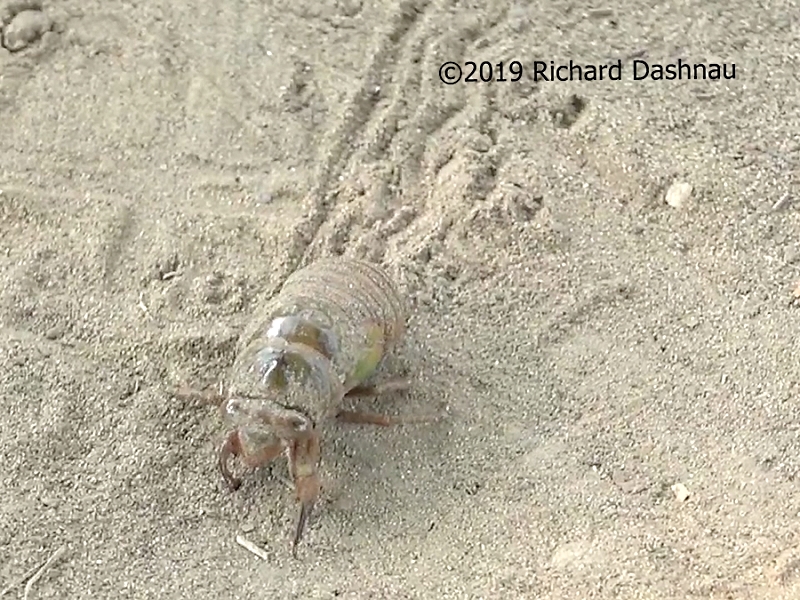
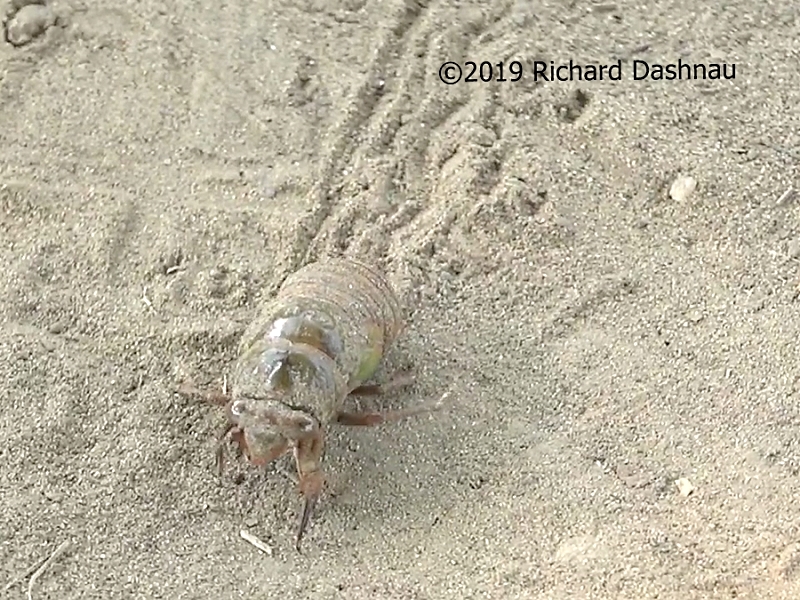
June 29
and July 6, 2014 Robber
Flies (especially the large ones) can make an impression just by
flying
by. Sometimes, they are carrying something they just caught. And
sometimes they
just
fall nearby with something they've just ambushed in mid-air.
Here
are a few images that I took on these two days. Note that I uploaded
(published) them in 2016, although I took the
pictures below in 2014. First is one that was patrolling from that
stalk. The
next image was at the Nature Center, and I had seen the Robber
Fly land on the building. It has caught a wasp.
The
third image shows a fly that fell to the trail in front of me,
with a
dragonfly it had caught. The fourth image shows a fly on the
rail
around the air conditioner at the Nature Center, and it
seem to have something,
but I can't tell what it is.
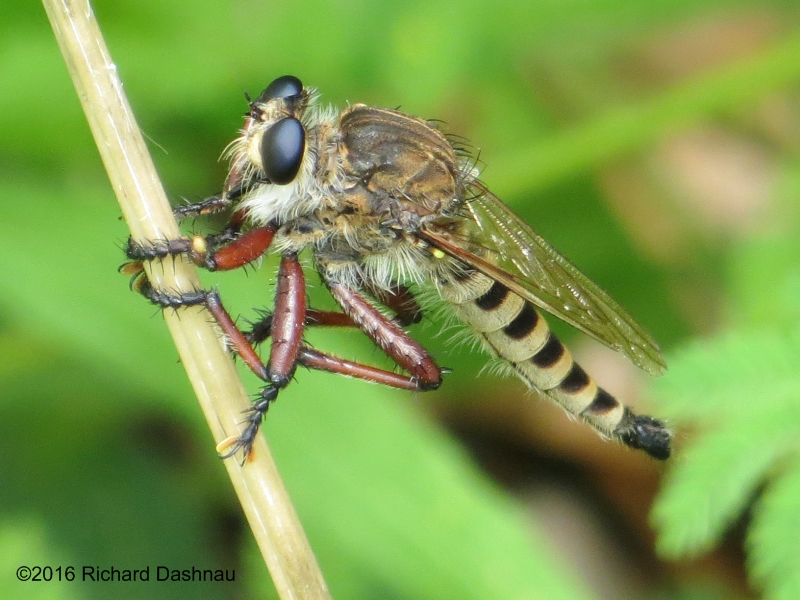 -
-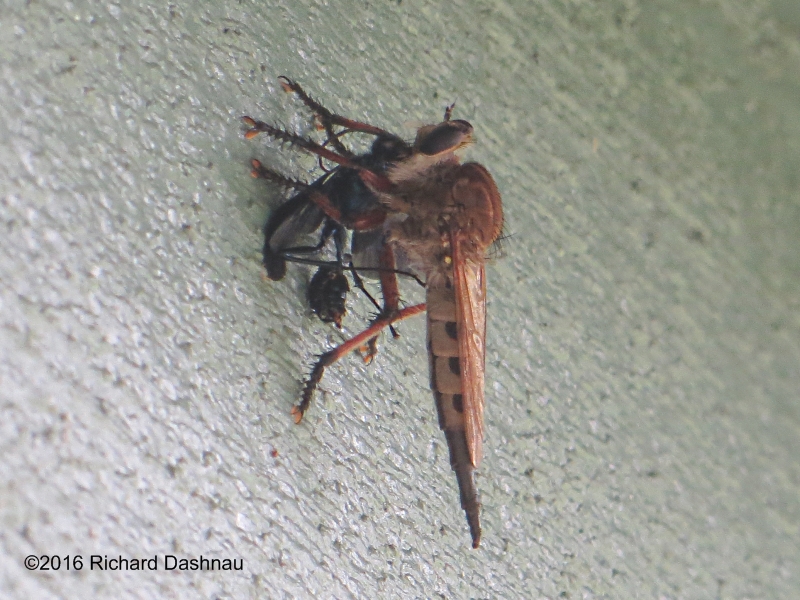 -
-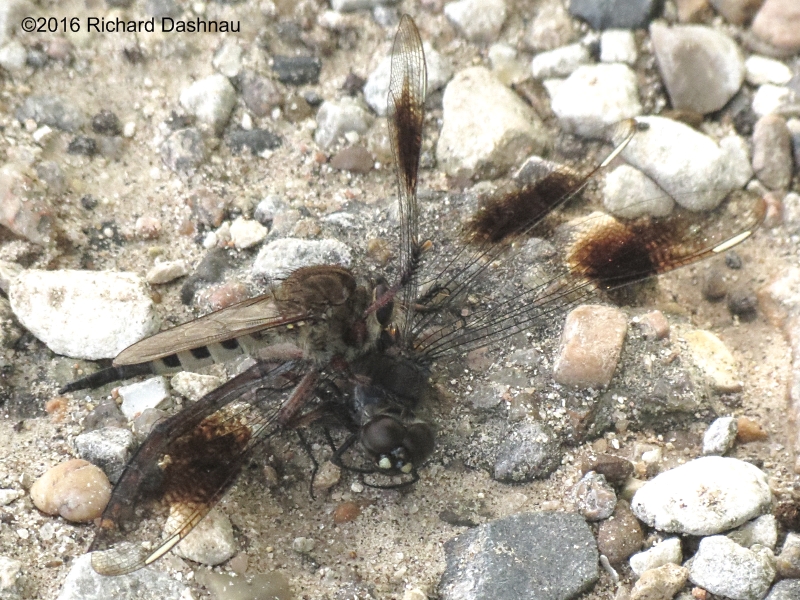 -
-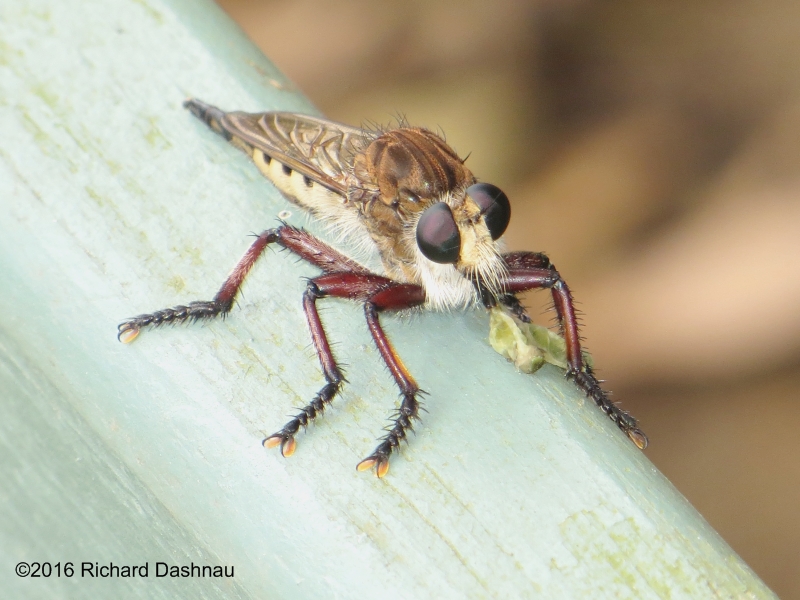 --
--
February
01, 2013 Today
I
visited the wonderful Houston Museum of Natural Science again,
something I've been doing a lot more since the new Paleo Hall
opened.
However, today I visited
the Cockrell Butterfly center, and
the Brown Hall of Entomology. I went through the
Hall first,
thinking that I might need to pick up some information before
entering
the rainforest of the Butterfly
Center. The hall of Entomology also
discusses some of the other arthropods besides insects. There was
a
large spider that must have gotten loose. I looked around, but
just
couldn't seem to
find it.... (see the RICKUBISCAM image below)
--------------------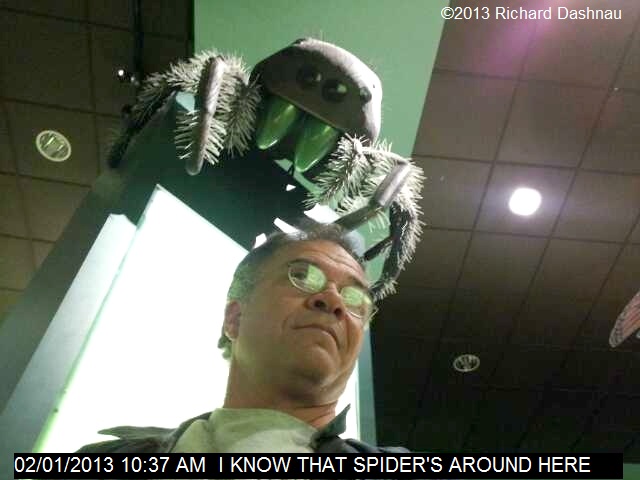
After
escaping, I continued through the Hall, where I saw the butterfly
"chrysalis corner". I observed people inside the cages,
gathering
butterflies. I didn't realize the importance of of this until
just a
few minutes later. I finally entered the rainforest, where
water
fell from the a rock face to a pool about 1 story below. In about
a
minute, I noticed all the butterflies flying around. And...
...I
got to see the release of newly-changed butterflies! Some
were
ready to fly--but others hadn't had their wings fully-hardened
yet.
These were gently placed on trees, to hang there like
Christmas
ornaments.
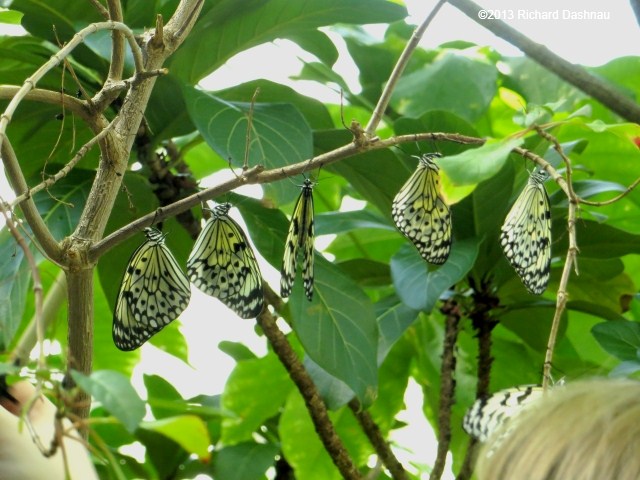
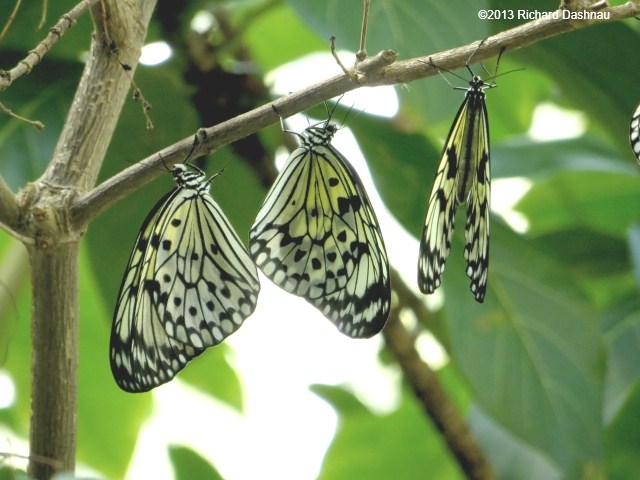 ___
___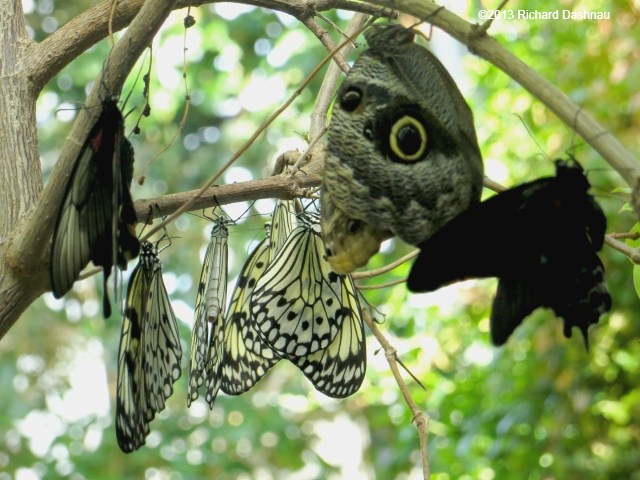
HANGING
LIKE
ORNAMENTS
Rice
Paper Butterfly (Idea leuconoe)
As
I looked at the butterflies hanging there, and while I was
chatting
with one of the entomologists, I suddenly remembered a picture I
had
seen just a week ago. It was a butterfly that had
coloration on
its wingtip that resembled the head of a snake. Just then, I was
looking at the very same species of butterfly--about 2 feet in
front of
me! I could have touched it (but I didn't,
because that can
damage the wings by rubbing the surface off) but I did take some
pictures with my pocket camera. From what I can see from the
identification sheets that the museum
loans out, it is a Tawny Owl
Butterfly (Caligo memnon). Now, I'll admit that
when I saw
the article and and picture on the internet, I was a bit
skeptical.
After all, of what good would it be for
the edge of the wing of a
butterfly to resemble a snake's head? How would that work as
camouflage--especially considering that the butterfly also has two
LARGE spots and colors on the
wings that closely resemble the wide eyes
of an owl.
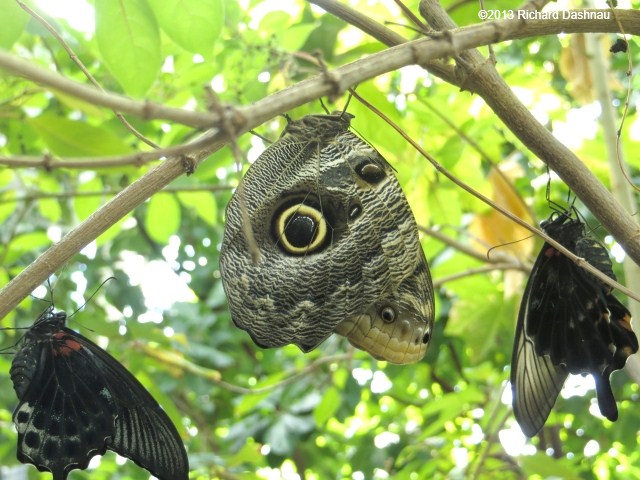
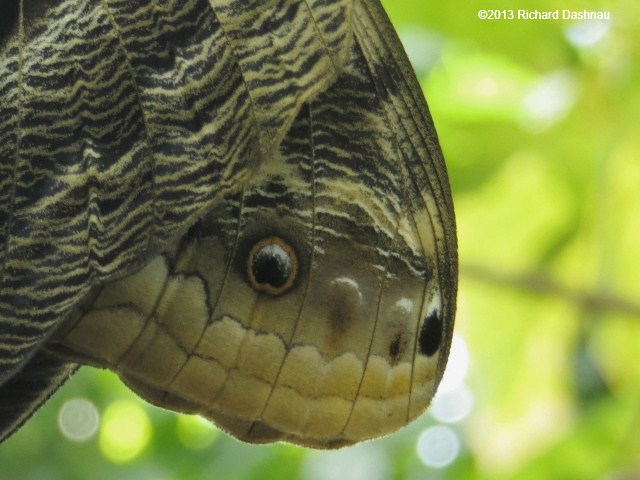 ___
___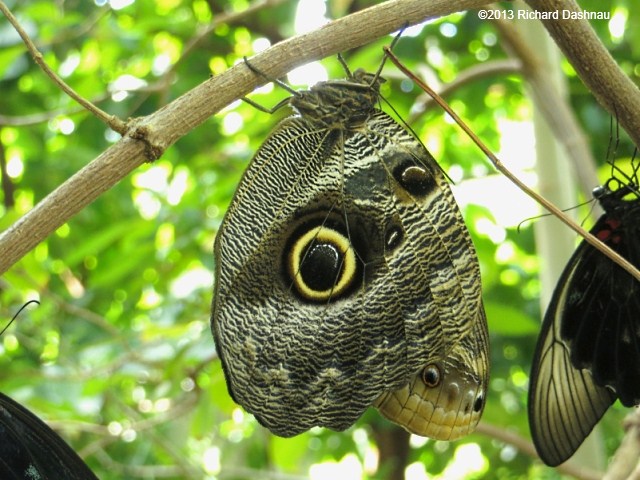
Tawny
Owl
Butterfly (Caligo memnon)
SNAKE'S
FACE!! NO, IT ISN'T
SNAKE WITH
HEAD UNDER 1 COIL
I
think I may have stumbled onto just the right time and place to
show
how the snake's head might work. The butterflies wings were still
not
fully-expanded (but almost). AND... the butterfly was
hanging
upside-down. Seen in this way (and maybe the light was just
at the
right angle--I don't know), the *entire* butterfly in
profile
looks like a coiled snake, with the head underneath the
coils. At least
it does to me. Since the butterfly can't
fly yet, maybe appearing as a coiled snake would scare predators
away.
This can only be verified by expermentation with whatever
would
normally attack this butterfly in it's home ecosystem.
I followed the trail and enjoyed the rainforest for a
while longer, and then continued to the Energy and Paleo halls.
10/19/2009--Green
Darners
(Anax junius) are one of the largest dragonflies.
Sometimes, if I catch it right, I can watch one stationary
in
the
air as it flies against a wind. The image below
is
a framegrab from a high-framerate video that I shot of a Green
Darner
caught this way. The video
clip
is here.
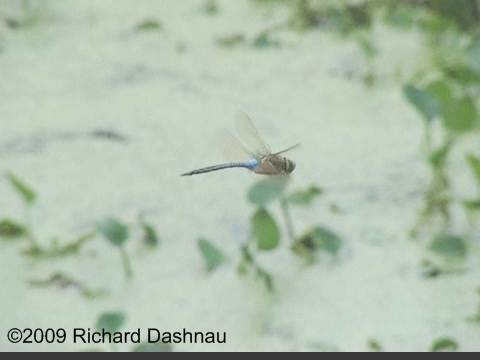 -
-
4/30/2006--This
is the last story from this single day, and last for for April as I
continue
my update bonanza.
While
inspecting the deck near the VC/NC, I found this caterpillar
resting
along
one of the crosspieces. Caterpillars are hard to identify, but a
cursory
inspection gives me the impression that
it resembles the larva of a moth.
This moth is called the Gloomy Underwing, or Andromeda Underwing (catocala
andromedae). Underwing moths are called so because the pair
of rear
wings is usually a contrasting color from the pair of front wings.
These
are held under the front wings (which are usually a color
well-suited
for
camouflage). The moth can suddenly show these
highly-contrasted underwings,
which causes a startling color effect.
Searching
the internet yielded the information that this particular larva
seems
to
have a diet consisting of a number of
plants. For one website out of my
domain that describes this moth, click here.
For
more information on caterpillars in general--also outside my
domain--click
here.
Why
did this catch my attention? Look how BIG this caterpillar is!
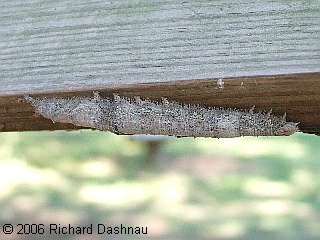 -
-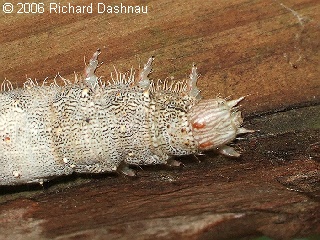 -
-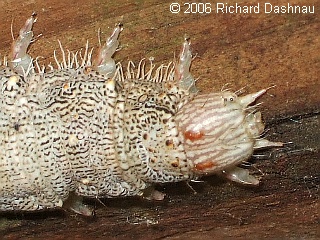 -
-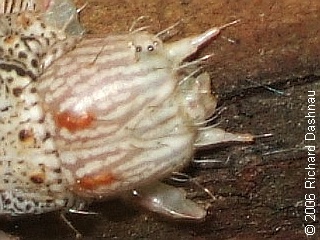 ----
----
AT
REST
HEAD
END
CLOSER
EVEN
CLOSER
PAIRS OF EYES AND TWO DARK SPOTS
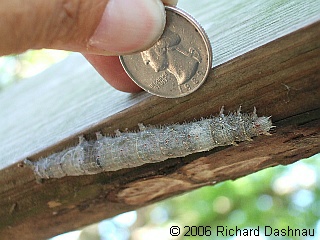 --
--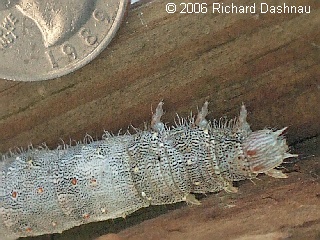
WITH A
QUARTER
THE QUARTER, CLOSER
June
20, 2004. Volunteer
Chuck Duplant found this
GIANT walkingstick on one of our trails. When I walked into the
Visitor's
Center and saw it, I just couldn't believe what I was seeing!
It's
kind
of surreal to see a live insect as large as this right in front of
you.
According to some websites, the giant walkingstick (Megaphasma
dentricus)
is the longest insect in the U.S. The
image below (QUARTERSTICK) shows
the giant walkingstick with a quarter (and my hand) for scale.
WOW!
They
are relatively harmless, though, unless you are an oak leaf.
That
is, they
are herbivores, and are not known to use any offensive chemical
defences (not like the two-striped
walkingstick, Anisomorpha bupestroides) . Below are
a few more
pictures of this
humongous insect. First (RICK STICKING AROUND) shows me
(I'd been working outside) holding the giant walkingstick. The
next
(RICK'S
NEW FRIEND, CLOSER) is a cropped closeup
of the same image. The third (LET'S
SHAKE HANDS) is a face-on view as it is walking up my arm. The
fourth
(BIG
AS MY HAND) is a frame from a short
video
clip showing it crawling on
my hand. It *is* as big as
it looks, and it's alive!.
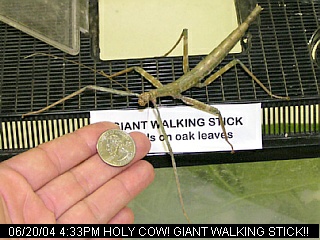 -
- -
-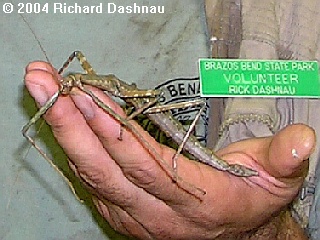 -
-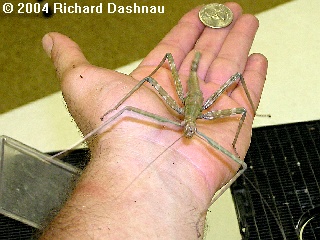 -
-
A QUARTER STICK
RICK STICKING AROUND
RICK'S NEW FRIEND, CLOSER
LET'S SHAKE HANDS
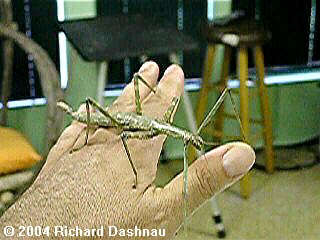
WALKING ON MY HAND!
WALKING
ON
MY HAND VIDEO 584KB
August
24, 2003On
a different note, I have to relate an incident that happened at
the
VC/NC
today. We've been gifted with the nocturnal appearance of a type
of
click
beetle that has two
spots that glow in the dark like eyes. Evidently, the
appearance of this beetle was exciting news for some local
entomologists.
They (the beetles, not the entomologists) are quite
striking,
and the glow
from the spots is easily visible in a lighted room with just a
small
amount
of shading. One of the park people had taken a beetle out to
show
everyone, and we were all being
impressed. I turned my back for a second,
and when I looked again, everyone was looking up.
"Where'd
it go?"
"It
went up towards the light!"
"There
it is; it---OOP! Spider got it!"
There
were a few moments of silence....
Most
beetles can fly. This species of click beetle can fly. It flew
from the
palm of the hand holding it to land on the upper edge of one of
the
fluorescent
lights---where, we (and the click beetle)
discovered, a spider lived. When
it landed, a spider immediately ran out, grabbed it, and
disappeared
back
above the light. End of beetle. Fortunately, there
are many,
many more.
August
4/August 5 2002This
story
actually
started right after my encounter with the arboreal Dolomedes
Albineus.
The Live Oak trees near the Visitor's Center have had large mats
of
silk
on the bark for some time. In spots, this silk is quite thick, and
many
visitors, and some volunteers (including me) also wondered what
caused
it. See (SILK 1, 2, 3, below)
-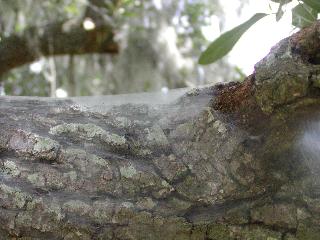 -
-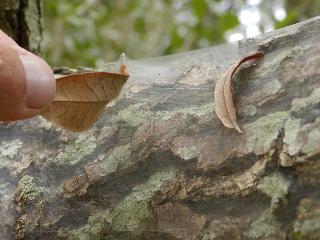 -
-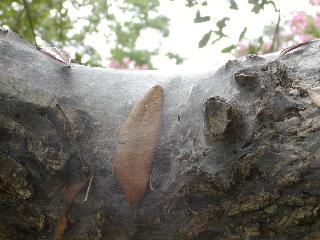
SILK
1
SILK
2
SILK
3
Close
examination didn't show anything obvious (like spiders or
caterpillars).
I'd wondered if the silk had anything to do with the Dolomedes,
but the
link was just circumstantial (both
happened to be in the same tree).
Finally David (park naturalist) had an answer (well, I guess no
one had
asked him before.). The creatures responsible were called
"barklice".
These
are
not true lice, but actually insects. Well, of course, I had to
find
more information. I looked on the internet, and found some
information,
but not many pictures. So, I decided to go back to the
park Monday (August
6. I'm taking time off from work anyway. HAHAHA!) and try to see
some
of
these insects. I was successful! Some of these images show a
closeups
of
one on a page
from a small notepad. One (UNDER THE SILK, below) shows them
on the tree, after I've pulled some of the silk away. These
insects are
extremely small, and difficult for me to photograph.
I'll return and see
if I can get some better pictures. in the meantime, these will
have to
do.
--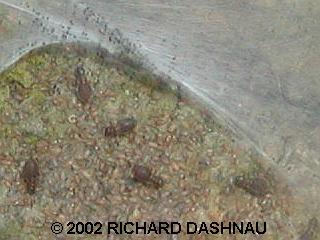 -
-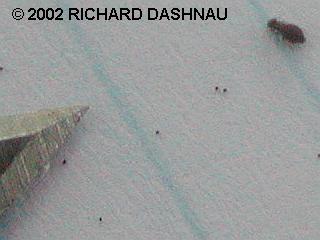 -
-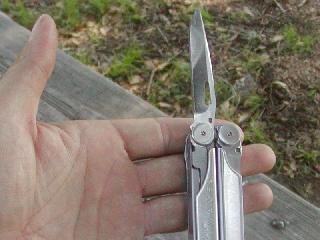 -
-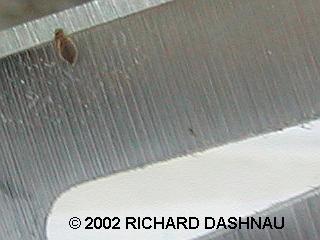
UNDER THE SILK
AT
KNIFEPOINT
THE KNIFE POINT
ON THE KNIFE BLADE
Ok.
So, these are barklice. But what are they? What do they do?
Well,
they are insects, in the order Psocoptera. They are very
small. They
live in large groups. They eat molds, fungi, pollen,
dead insects,
aphids, and other similar material. In short, they "clean the
tree's
bark".
The barklice build the silk mat to work under (click on these
links to
see video clips of barklice
part
1 (flv video 1,214kb), or, part
2
(flv video 618 kb)). After they're done (probably after
they've exhausted
a particular area of all small foodstuffs), they leave. According
to
some
accounts
I've read, they remove the webs. After finally seeing how small
these insects are, I'm amazed at the amount of silk that they can
produce.
This has to cost the insect some survival resources.
If they produce this
webbing by processing what they eat, then how much debris must
they
consume
just to produce a single silken strand? How much to cover the
large
areas
with those mats
of silk? These are not to be confused with the various
caterpillars that may build tents in the leaves of trees. Barklice
seem
beneficial for the tree, and seeing these webs (which are close to
the
bark, and not in a "tent" or "globe" configuration) should
probably be
a good omen for the tree. I, for one, am happy that
this "mystery"
is finally solved.
If
you'd like to know more about the park follow these links:
Brazos
Bend State Park
The main
page.
Brazos
Bend State Park Volunteer's Page
The
volunteer's main page.
Go
back to my home page, Welcome
to rickubis.com
Go
back to the RICKUBISCAM
page.
Go
back to the See
the World
page.































































 -
- -
- -
- --
--


















 -
- -
-



